The Root
- Books Name
- ACME SMART COACHING Biology Book
- Publication
- ACME SMART PUBLICATION
- Course
- CBSE Class 11
- Subject
- Biology
Classification of Plants
(A) On the Basis of Habit
On the basis of their form or habit, the flowering plants are usually classified into the following three categories
(a) Herbs: Herbs are small plants with soft stems. They may be annual (e.g., Mustard=Brassica campestris) , biennial (e.g. , Radish=Raphanus sativus) , or perennial (e.g., Canna).
(b) Shrubs: Shrubs are medium sized perennial woody plants which branch profusely from the base and attain a bushy appearance e.g., China rose (Hibiscus rosa-sinensis), Capparis decidua etc.
(c) Trees: A tree has a main stout and woody trunk which gives off branches only at some distance above the ground e.g., Mango (Mangifera indica), Shisham (Dalbergia sissoo) and banyan (Ficus benghalensis).
Concept Builder
On the basis of their branching, trees are classified into the following three categories.
(i) Caudex (Columnar). The stem is unbranched and usually bears a crown of leaves at the apex, e.g., Date palm (Phoenix dactylifera), Fan palm (Borassus flabellifer), etc.
(ii) Excurrent. The branches arise from the main stem in acropetal succession and the tree assumes a cone like appearance e.g., Pinus, Eucalyptus, Casuarina, etc.
(iii) Decurrent (Deliquescent). The lateral branches grow more vigorously and outcompetes the main trunk, giving a dome-shaped apperance, e.g., Mango (Mangifera indica), Shisham (Dalbergia sissoo) and Banyan (Ficus benghalensis).
(B) On the Basis of Mode of Nutrition
1. Autotrophs. These are photosynthetic plants synthesizing their own food, e.g., all green plants.
2. Heterotrophs. These plants can not synthesize their own food. They are of following types –
(a) Parasitic plants.
Depend on other plants for food and water. They have special structures for absorption of food and water. They may be
(i) Obligate or total parasite. Depend on other plants for both food and water.
• Total stem parasites. e.g., Cuscuta, Cassytha and Arceuthobium (smallest among angiospermic parasite, only the flowers are visible externally, A. minutissimum is found on stem of Pinus wallichiana).
• Total root parasite. e.g., Orobanchae (Broom rape), Balanophora, Rafflesia, Sapria, Cistanche.
(ii) Partial or semi -parasites. Depend on other plants for water and minerals only.
• Partial stem parasites. e.g., Viscum (Mistletoe), Loranthus .
• Partial root parasites. e.g., Santalum, Striga, Thesium.
(b) Saprophytic plants.
Grow on dead organic matter e.g., Monotropa (Indian pipe), Neottia (Bird's nest). They are mycotrophic plants.
(c) Symbiotic plants.
Symbiosis or mutualism is obligatory beneficial partnership of two organisms e.g., lichens (algae and fungi), Rhizobium (N2 fixing bacteria and leguminous plants), mycorrhiza (fungi and roots of higher plants).
Symbiotic relationship between ants and some higher plants is another good example where the ants obtain food and shelter from the plant.
They protect the plant from other animals e.g., Acacia sphaerocephala (Stipules are hollowed to function as ant shelter, leaflet tips and rachis possess feeding materials).
(d) Insectivorous or carnivorous plants.
They grow in soil deficient in nitrogen.
They trap insects and digest their protein.
These are chlorophyllous plants thus can synthesize their own food.
So all insectivorous plants are producers and secondary consumers.
Concept Builder
Some insectivorous plants are:
(i) Utricularia (Bladder wort). It is a rootless aquatic plant with highly dissected leaves. Some of the leaf segments are modified into small bladders which have trap valves for catching small animals like Cyclops and Daphnia.
(ii) Drosera (Sundew). It is a herbaceous plant growing in water logged places. The upper surface of its leaves possess club shaped tentacles. The tentacle heads secrete sticky purple juice that shines in the sun (hence called sundew). An insect touching a tentacle is stuck up and trapped by bending of tentacles. The trapped insect is then digested by enzymes secreted by digestive glands and amino acids are absorbed by the leaf.
(iii) Dionaea (Venus fly trap). It is a herbaceous plant bearing rosette leaves. Leaves have winged petiole and lamina modified into two toothed jaws (bilobed) normally open at an angle forming a trap. Each jaw contains several teeth. Upper surface of each jaw (lobe) bears sensitive hair, spines or bristles (three in number) and digestive glands.
Stimulation of a sensitive spine or hair by an insect causes folding of leaf and secretion of digestive juices.
(iv) Nepenthes (Pitcher plant). It is a climber. The pitcher is formed from the lamina of leaf and the lid is the modified leaf tip. The flattened leaf like part below the petiole is the leaf base. Petiole is elongated and tendrillar. A large number of glands are situated on the upper half of the inner wall of pitcher which secrete proteolytic enzymes. The enzymes hydrolyse the protein of insects and amino acids so produced are absorbed by the plant. Sarracenia, Darlingtonea and Cephalotus are other insectivorous pitcher plants.
(v) Aldrovanda (Water flea trap). It has a thin rootless floating stem, which bear whorls of modified leaves. Each leaf has a spathulate stalk and a folding two lobed lamina with teeth round the edges. The surface bears numerous sensitive joined hairs and digestive glands.

A. Nepenthes, B. Drosera, C. Dionaea
(e) Epiphytes.
These plants grow on other plants for shelter only (for physical support).
They synthesize their own food.
They have special hanging roots called hygroscopic roots to absorb moisture from atmosphere by thin walled cells lying outside called velamen, e.g., Orchids like Vanda, Dendrobium, etc.
(C) On the Basis of Life Span
Three categories of plants are recognised on this basis
(i) Annuals:
The plants which complete their life cycle in a single season or few weeks or few months are called annuals.
They grow and produce flowers and fruits within this period and then die off, e.g., mustard (Brassica campestris), pea (Pisum sativum), wheat, maize, Euphorbia prostrata.
(ii) Biennials:
The plants which complete their life cycle in two growing seasons are called biennials.
In the first season, they grow vegetatively and in the next season, they produce flowers, fruits and seeds, e.g., carrot (Daucus carota), radish (Raphanus sativus) and turnip (Brassica rapa).
(iii) Perennials:
These are the plants which continues to grow for many years, e.g., peach (Prunus persica) and apple (Pyrus malus).
Perennials can be, monocarpic (which flower and fruit only once in life time) e.g., bamboo (Bambusa tulda), century plant (Agave), or polycarpic (which flower and fruit many times in life time), e.g., mango, pear.
Let us discuss various parts of a flowering plant
THE ROOT
True roots develop from radicle of seed.
They are non green, underground, positively geotropic, positively_hydrotropic and negatively phototropic.
Roots usually do not bear buds, but buds are present for vegetative propagation in adventitious root of sweet potato (Ipomoea) and tap root of Indian red wood (Dalbergia).
They do not bear nodes and internodes.
They have unicellular roots hairs.
Lateral roots arise endogenously, i.e., from pericycle.
Zonation in Roots
(i) Root cap.
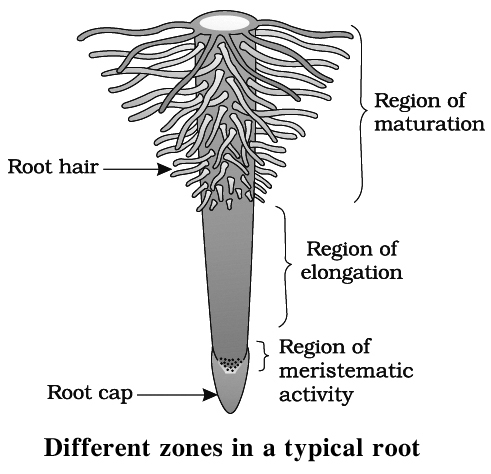
At the apex of root a smooth cap shaped structure is present which is called as root cap.
It is protective.
Multiple root cap is found in aerial roots of screwpine (Pandanus).
In hydrophytes, root cap is either absent or replaced by root pocket, e.g., Pistia, Lemna, Eichhornia.
(ii) Zone of cell formation or division.
The cells of this region are inactive state of division and their number increases continuously.
Vacuoles are small or absent.
(iii) Zone of cell elongation.
Maximum growth in the cells occurs in this zone.
Cells have a large central vacuole.
(iv) Zone of cell maturation.
The cells in this region are differentiated into permanent tissues depending upon the functions they have to perform.
Root hairs are also present in this zone which help in absorption of water.
In hydrophytes, root hairs are absent because they absorb water through general body surface.
Types of Roots
Roots are of two types :
(1) Tap roots. Primary root developing from radicle. The primary root grows and gives rise to secondary and tertiary roots forming the tap root system, e.g., dicots.
(2) Adventitious roots. They develop from any part of the plant body other than the radicle. They are called adventitious roots, e.g., monocots.
1. Modifications of Tap Root :
A. Storage or fleshy tap roots.
They store food and assume various shapes.
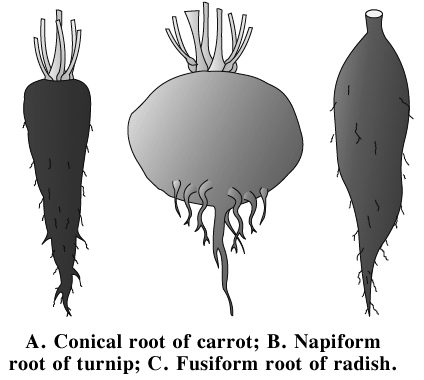
(i) Conical: Cone like, e.g., carrot.
(ii) Napiform: Swollen in the upper part and apruptly tapers in lower part, e.g., turnip and beet root.
(iii) Fusiform: Spindle shaped, e.g., radish.
B. Respiratory root.
Some plants like Avicennia and Sonneratia, which grow in salty marshes (mangroves) develop special kinds of roots for respiration.
These roots are called respiratory roots or pneumatophores.
They arise in conical shape from the branches of underground tap root and grow vertically upwards (i.e., negatively geotropic) into the air.
The upper portions of these roots have numerous aerating pores, called pneumatothodes.
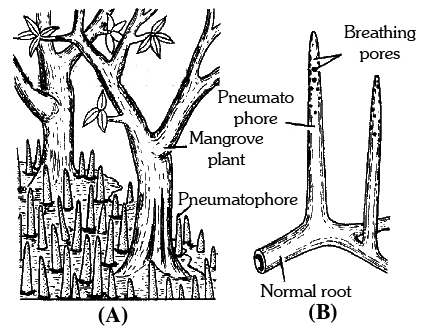
Pneumatophores (respiratory roots) of a mangrove tree:
A. Main plant with emerging pneumatophores; B. Pneumatophores enlarged
C. Nodulated roots –
 These are found in members of family Papilionaceae for nitrogen fixation. Symbiotic bacteria of the genus Rhizobium are present in nodules to fix atmospheric nitrogen.
These are found in members of family Papilionaceae for nitrogen fixation. Symbiotic bacteria of the genus Rhizobium are present in nodules to fix atmospheric nitrogen.
2. Modifications of Adventitious Root
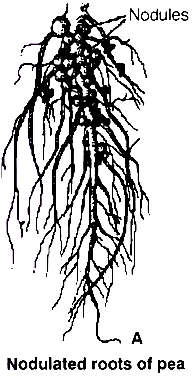
A. Storage adventitious roots
(i) Tuberous. Single root arises from node of stem and becomes tuberous and fleshy for storage of food, e.g., sweet potato.
(ii) Fasciculated. Roots arise in bunch (cluster) from lower node of stem and become fleshy, e.g., Dahlia, Asparagus.
(iii) Nodulose. Root apex becomes swollen and fleshy, e.g., mango ginger (Curcuma amada).
(iv) Beaded or Moniliform. Roots swell up at regular intervals forming beaded structure, e.g., Portulaca, Momordica (bittergourd).
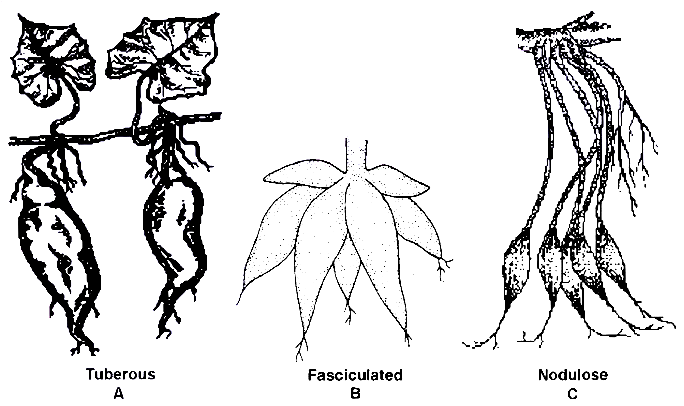
Modifications of adventitious roots : A. Tuberous roots of sweet potato;
B. Fasciculated roots of Dahlia; C. Nodulose roots of mango ginger
(v) Annulated. Roots having series of ring like swellings e.g., Ipecac (Psychrotia).
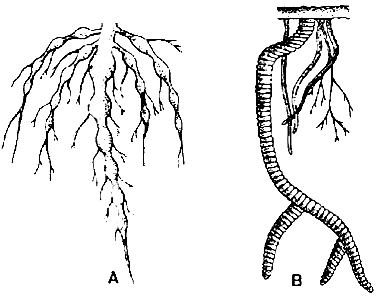
A. Moniliform roots of Momordica; B. Annulated roots of Ipecac.
B. Adventitious roots that provide extra support
They are of following types:
(i) Prop roots. They arise from the branches of stem for providing mechanical support to heavy branches, as pillars, e.g., old banyan tree (Ficus benghalensis).
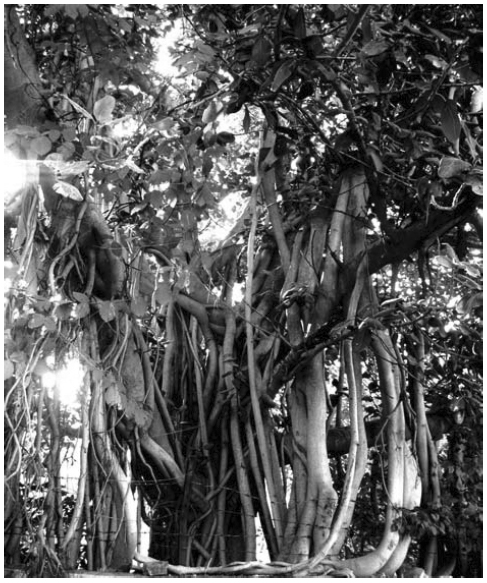
Modification of adventitious root: Prop roots of banyan
(ii) Stilt roots. They arise from lower nodes of stem to support main axis and enter the soil obliquely, e.g., sugarcane, maize, screwpine (Pandanus).
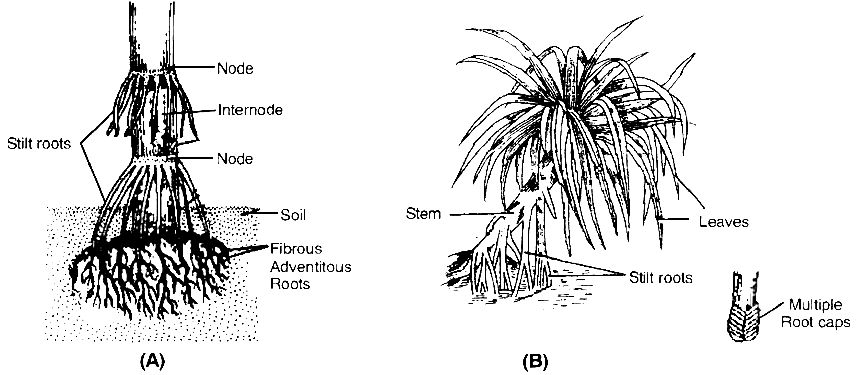
Modifications of adventitious root: A. Stilt root of sugarcane; B. screw pine
(iii) Climbing roots. They arise from nodes and help the plants in climbing, e.g., Pothos, Piper.
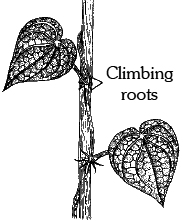
Modification of adventitious roots: Climbing root of Piper
(iv) Buttress roots. They arise from basal parts of main stem and spread in different directions in the soil, e.g. , Bombax, Ficus religiosa .
Concept Builder
Adventitious root with special functions
(i) Floating roots. In aquatic plants (e.g., Jussiaea) white spongy roots arise from branches and help in floating and respiration.
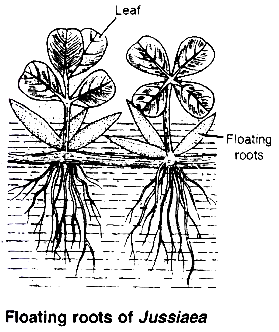
 (ii) Assimilatory roots. The aerial roots of Tinospora and submerged roots of Trapa (Water chestnut) become green and synthesize food. Podostemon also has green assimilatory roots.
(ii) Assimilatory roots. The aerial roots of Tinospora and submerged roots of Trapa (Water chestnut) become green and synthesize food. Podostemon also has green assimilatory roots.
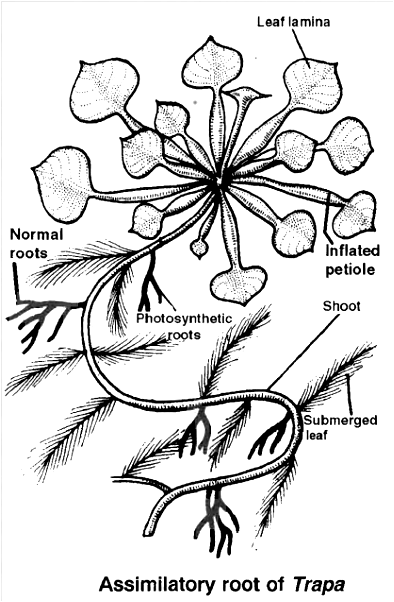
(iii) Sucking or haustorial roots. These roots suck food and water from host and are found in parasitic plants e.g., Cuscuta, Orobanche, Viscum.
(iv) Hygroscopic roots. These are found in epiphytes, specifically orchids and help in absorption of moisture from the atmosphere using special tissue called velamen.
(v) Contractile roots -They shrink 60 -70% of the original length and bring underground organ at proper depth in the soil e.g., corm of Crocus (saffron), Freesia .
(vi) Root thorns -These are hard, thick and pointed thorns e.g., Pothos armatus and Acanthorhiza.
(vii) Clinging roots - These are non absorptive adventitious roots arising either from nodes (e.g., Tecoma, betel), internodes (Ficus pumila) or both (e.g., juvenile stage of Ivy).
(viii) Reproductive roots - These are fleshy, adventitious roots used for vegetative reproduction e.g., sweet potato (Ipomoea batatas) , Dahlia.
(ix) Leaf roots - In Salvinia, one leaf of each node modifies into root like structure for balancing the plant in water.
(x) Epiphyllous roots - These roots arise from the margins of leaf lamina for vegetative reproduction e.g., Bryophyllum. 
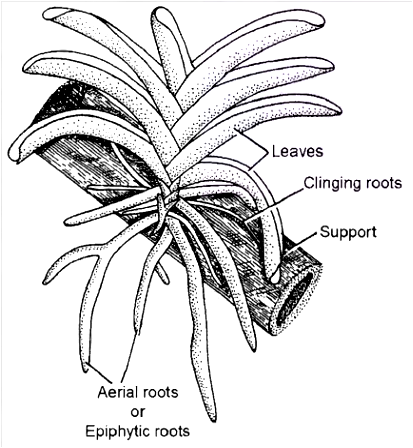
Modification of adventitious root: Epiphytic roots of Vanda (an orchid)
Functions of Root
The root performs various functions like –
Fixation, Absorption, Conduction, Storage, Reproduction, Assimilation, Nitrogen fixation, Floating and Balancing and provides Mechanical support.
The Root
Chapter 5
Morphology of flowering plants
Angiosperms have a wide range of exterior forms or morphology, but they all have roots, stems, leaves, flowers, and fruits in common. Flowers and fruits may be present. The root system of a flowering plant is underground, whereas the component above ground is called the shoot system.
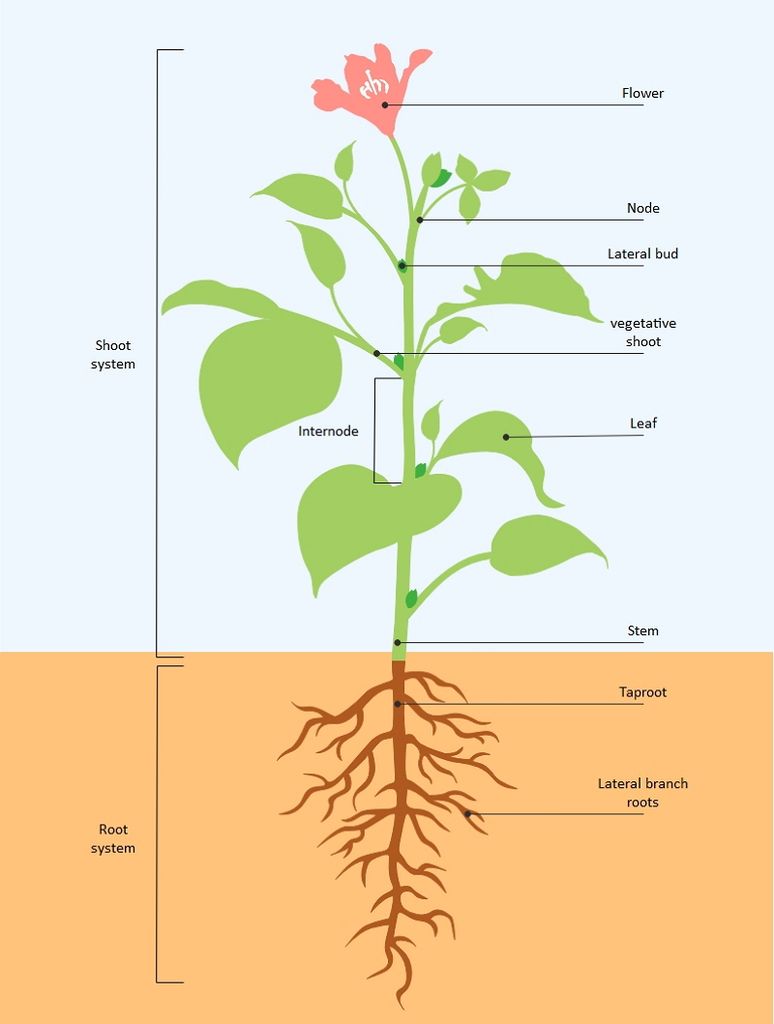
The Root
All vascular plants have roots, which are a crucial subterranean component. This portion of the plant is primarily responsible for attaching it to the ground and absorbing the soil's necessary mineral components, nutrients, and water. It can also be used to keep food.
Types of roots:In the majority of dicotyledonous plants, direct radicle elongation results in the creation of the main root that grows inside the soil. It has lateral roots of several orders, referred to as secondary, tertiary, and so on. This is called the taproot system, as shown in the mustard plant. It is made up of the major roots and their branches. The primary root of monocotyledonous plants is short-lived and is replaced by a vast number of roots.As shown in the wheat plant, these roots grow from the base of the stem and form the fibrous root system.
Adventitious roots emerge from portions of the plant other than the radicle in some plants, such as grass, Monstera, and the banyan tree. Absorption of water and nutrients from the soil, appropriate anchorage of plant parts, storage of reserve food material, and synthesis of plant growth regulators are the key tasks of the root system.
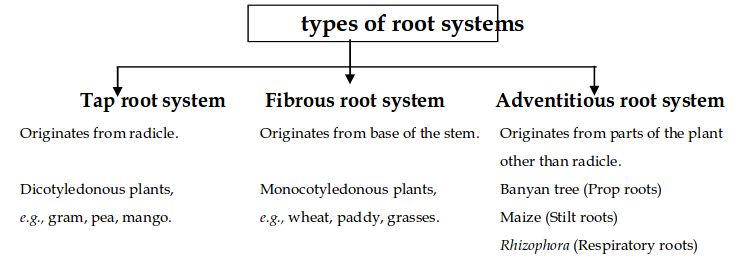
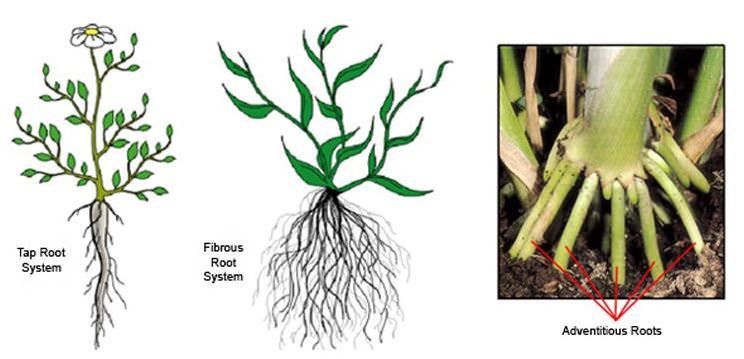
Regions of a root:The root cap is a thimble-like structure that covers the root at its tip. It shields the root's fragile apex as it travels through the soil. Meristematic activity occurs a few centimeters above the root cap. This region's cells are tiny, thin-walled, and have thick protoplasm. They repeatedly divide. The cells closest to this region experience rapid elongation and expansion, and they are responsible for the root's length growth. The elongation region is the name given to this area. The elongation zone's cells mature and differentiate throughout time. As a result, the zone proximal to the region of elongation is known as the maturation zone.Root hairs are incredibly tiny and fragile thread-like structures formed by epidermal cells in this region. The soil's water and minerals are absorbed by these root hairs.
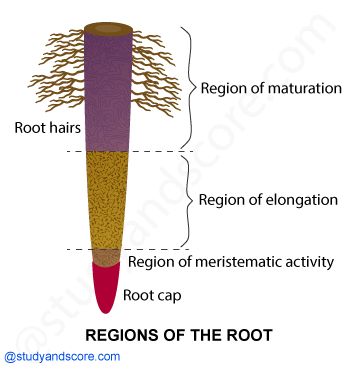
Modifications of a root:Some plants' roots change shape and structure, allowing them to perform roles beyond water and mineral absorption and conduction. They've been altered to provide support, food storage, and breathing. Carrot, turnip, and sweet potato adventitious roots are used for the storage of food in plants. Prop roots are the hanging structures that support a banyan tree. Similarly, maize and sugarcane stems have supporting roots that emerge from the lower nodes of the stem. They are called Stilt roots. Many roots emerge from the ground and climb vertically upwards in plants like Rhizophora that flourish in swampy environments. Pneumatophores are roots that aid in the acquisition of oxygen for breathing.
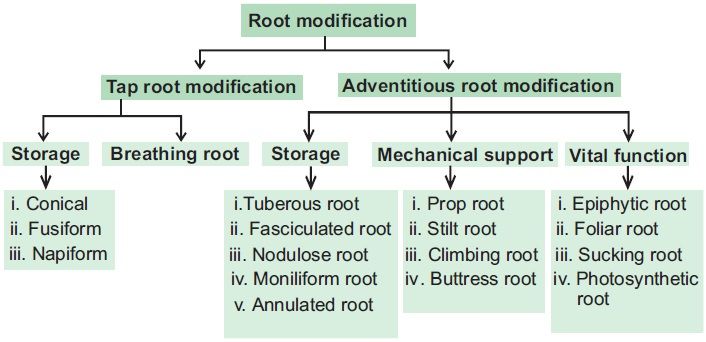
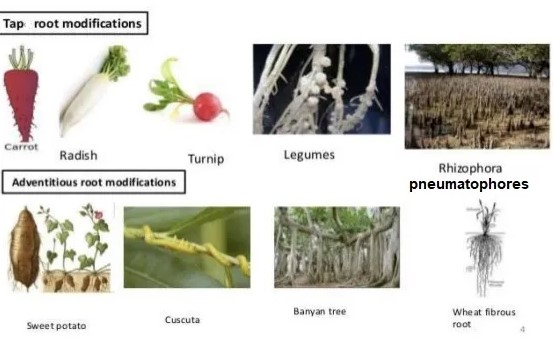
The Stern
- Books Name
- ACME SMART COACHING Biology Book
- Publication
- ACME SMART PUBLICATION
- Course
- CBSE Class 11
- Subject
- Biology
THE STEM
Stem is ascending part of plant and formed by the prolongation of the plumule of embryo.
It is positively phototropic and negatively geotropic and hydrotropic.
It bears nodes and internodes.
Leaf bearing part of stem is called shoot.
It has buds.
It may bear multicellular hair on external surface.
Lateral branches arise from the cortex (exogenous origin).
Bud is a condensed, immature or embryonic shoot with closely placed nodes.
These have a growing point surrounded by closely arranged immature leaves.
Cabbage is the largest bud.
Buds can be Vegetative, Floral and Modified
1. Vegetative buds.
These buds develop into vegetative shoots. They can be:
(a) Terminal or apical bud - Present on the tip of branches.
(b) Axillary or lateral bud - Present in the axil of leaves.
(c) Some plants regularly produce some extra buds on the side of axillary buds called as accessory or supernumerary buds.
(d) Buds which develop from any part of the plant body other than the above mentioned ones are called adventitious buds. These can be :
(i) Cauline buds - Arise directly from stem e.g., Artocarpus (Jack fruit).
(ii) Radical buds - Arise on roots e.g., Sweet potato, Dalbergia.
(iii) Foliar buds - Buds which develop on the leaves e.g., Bryophyllum, Begonia (Elephant ear plant), Kalanchoe etc.
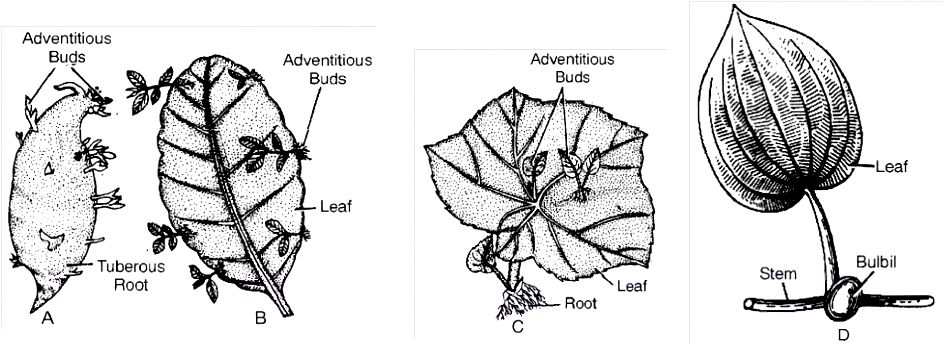
 Adventitious buds: A. Radical buds of sweet potato B. Foliar buds of Bryophyllum ,
Adventitious buds: A. Radical buds of sweet potato B. Foliar buds of Bryophyllum ,
C. Foliar buds of Begonia D. Bulbil of Dioscorea
2. Floral buds : These buds always develop into flowers.
3. Modified buds: They can be both vegetative or floral buds.
a. Vegetative bud modification
(i) Tendrlis – e.g., Passiflora (Passion flower).
(ii) Thorns – e.g., Citrus (Lemon) , Duranta, Carissa
(iii) Bulbils – e.g., Dioscorea (Yam). Cycas (gymnosperm).
b. Floral bud modifications
(i) Tendrils – e.g., Cardiospermum (Balloon vine).
(ii) Bulbils – e.g., Allium sativum (Garlic)
Types and Modifications of Stem
A. Aerial stems (Epiterranean stem)
It may be reduced, erect and weak.
1. Reduced -Stem reduced to a disc. e.g ., Radish, Carrot, Turnip.
2. Erect stem -It is strong and upright e.g., Maize, Wheat, Mango. An erect stem with swollen nodes is called culm (e.g., bamboos).
3. Weak stems -These are thin, soft and weak and need support. They can be upright or prostrate.
(a) Creepers. The stem creeps on earth and the roots arise at the nodes, e.g., grasses, strawberry, Oxalis.
(b) Trailers – The stem creeps on the ground, but the roots do not arise at the nodes. They may be:
(i) Prostrate or procumbent. The stem creeps on ground totally, e.g., Evolvulus.
(ii) Decumbent. When prostrate stem projects its tip, e.g., Portulaca, Lindenbergia. 
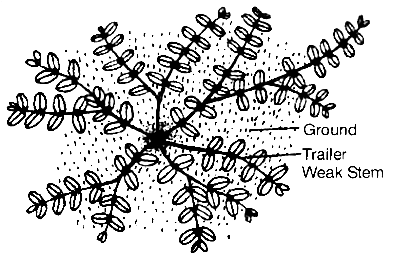
(c) Lianas (Stem climber). Woody perennial climbers found in tropical rain forests are lianas. They twine themselves around tall trees to secure sunlight, e.g., Hiptage, Bauhinia vahlii (Phanera).
(d) Climbers. Plants are with long weak stem and have organs of attachment to climb the object. They maybe
(i) Rootlet climbers. Roots produced at nodes help in climbing e.g., Tecoma, Pothos, Piper betel (pan).
(ii) Hook climbers. In Bougainvillea, Ouranta and Carrisa, the thorn is modification of axillary vegetative bud which helps in climbing. In Bignonia, terminal leaflet is converted into hook. Artobotrys and Uncaria are also hook climbers.
(iii) Tendril climbers. Tendrils are thread like structures which help the plants in climbing.
Concept Builder
Tendrils are modifications of:
• Entire leaf -Leaf tendril e.g., Lathyrus sativus.
• Leaflet -Leaflet tendril e.g., Pisum.
• Petiole -Petiolar tendril e.g., Clematis, Nepenthes.
• Stipule -Stipular tendril e.g., Smilax.
• Leaf apex -Leaf apex or tip tendril e.g., Gloriosa.
• Inflorescence -Inflorescence tendril e.g., Antigonon.
• Stem -Stem tendril e.g., Vitis (modified apical bud), Passiflora (modified axillary bud).
(e) Twiners. The stem body twines around the support without any special organ of attachment. e.g., Cuscuta, Dolichos and Quisqualis.
B. Underground Stem Modifications
(a) Rhizome:
It grows parallel or horizontal to soil surface.
It bears nodes, internodes, buds and scaly leaves e.g., Ginger, Banana, Turmeric, Ferns.
It is of two types:
(i) Rootstocks:
It is upright or oblique with the tip almost reaching the soil surface e.g.,Dryopteris.
(ii) Straggling:
It is horizontal and branched.
Branching may be –
Racemose - Axis is monopodial, e.g., Saccharum, Lotus.
Uniparous cymose - Axis is sympodial, e.g., Zingiber officinale (ginger), Curcuma domestica (turmeric) and Canna.
(b) Tuber.
It is terminal portion of underground stem branch which is swollen on account of accumulation of food, e.g., Potato, Helianthus tuberosus (Jerusalem artichoke).
(c) Corm.
It grows vertically beneath soil surface.
It is usually unbranched.
It bears nodes, internodes, buds and scale leaves, e.g., Colocasia, Gladiolus, Colchicum, Crocus, Amorphophallus.
(d) Bulb.
Stem is reduced and disc shaped.
The bud is surrounded by many concentric scale leaves.
Leaf bases of inner ones are fleshy and edible and of outer ones are dry e.g., onion, lily, garlic.
It is of two types -tunicated and scaly.
Tunicated bulb is covered by a sheath of membranous scales called tunic.
It may be simple tunicated bulb -covered by a sheath e.g. onion and Narcissus; or compound tunicated bulb-concentric rings of bulblets surrounded by a white membranous sheath or tunic e.g. garlic.
Scaly or naked bulbs do not have tunic. e.g., lily.
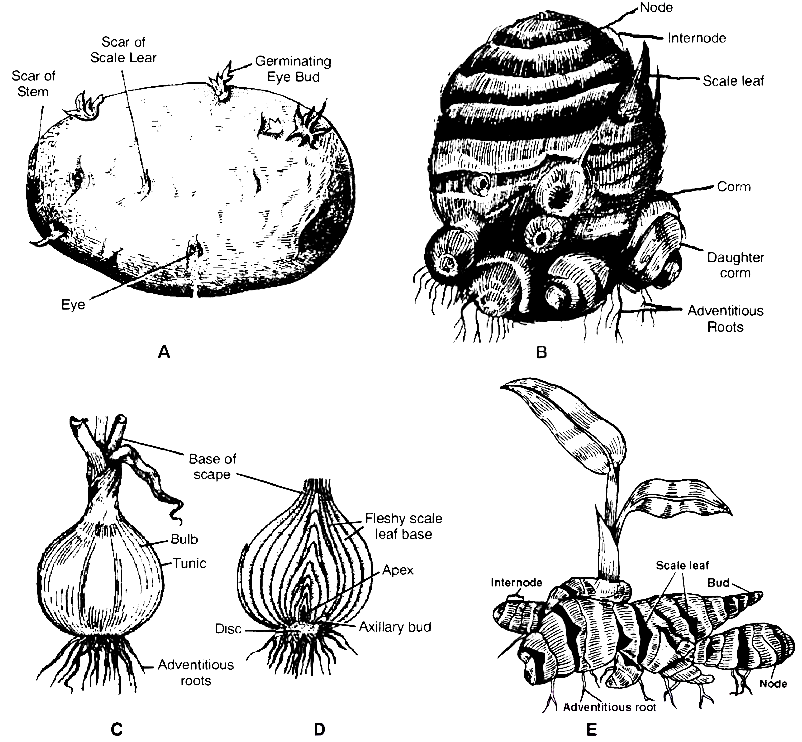
Underground modifications of stem: A. Tuber of potato; B. Corm of Colocasia
C, D. Tunicated bulbs of onion (C, entire; D, longitudinally cut) E. Rhizome of ginger
C. Sub-aerial Weak Stem
(a) Runner.
It is elongated, prostrate, aerial branch with long internodes and roots at nodes
e.g., Oxalis, grasses, Hydrocotyle.
(b) Sucker.
It arises by axillary bud of underground part of stem.
This lateral branch creeps below the soil surface and grows obilquely upward and produces new shoot.
e.g., Banana, Pin epple, Chrysanthemum, rose.
(c) Offset.
Short horizontal branch producing a cluster of leaves above and the cluster of roots below.
e.g., Pistia, Eichhornia.
(d) Stolon.
It is subterranean long lateral branch arising from base of the stem.
e.g., Colocasia, Rubus, Fragaria
It first grows obliquely upward and then bends down to the ground surface.
e.g., Jasminum
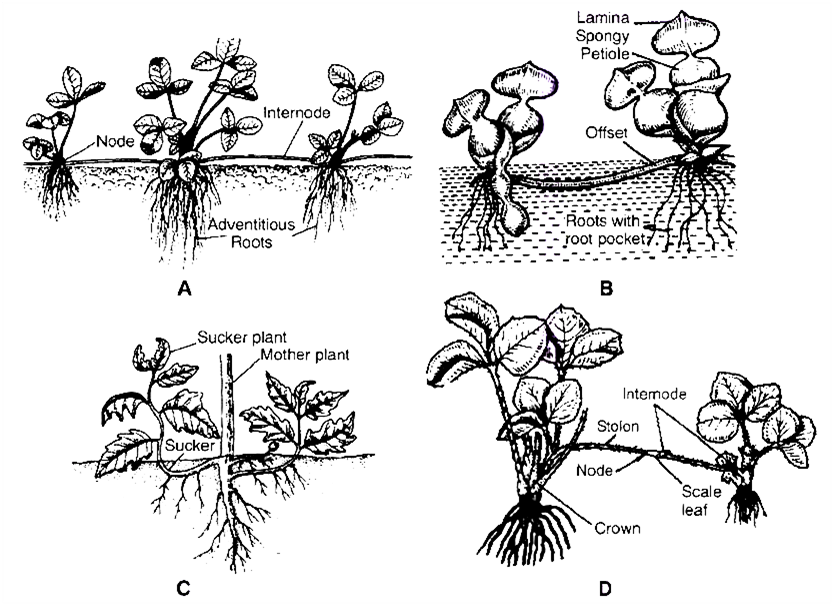
 Subaerial modifications of stem: A. Runner of Oxalis; B. Offset of Pistia;
Subaerial modifications of stem: A. Runner of Oxalis; B. Offset of Pistia;
C. Sucker of Chrysanthemum; D. Stolon of Fragaria
D. Special Stem Modifications
(a) Phylloclade. It is green flattened or rounded succulent stem with leaves either feebly developed or modified into spines e.g., Opuntia, Casuarina, Muehlenbeckia.
(b) Thorn. It is modification of axillary bud, e.g., Bougainvillea, Duranta, Carissa. Thorns of Alhagi possess flowers, while thorns of Duranta bears leaves.
(c) Cladode. Phylloclade usually having one internode long, is called cladode, e.g., Asparagus, Ruscus. It is of limited growth.
(d) Stem Tendril. It is a leafless, spirally coiled structure found in climbers. It may be a modification of axillary bud, e.g., Passiflora or terminal bud e.g., Vitis. 
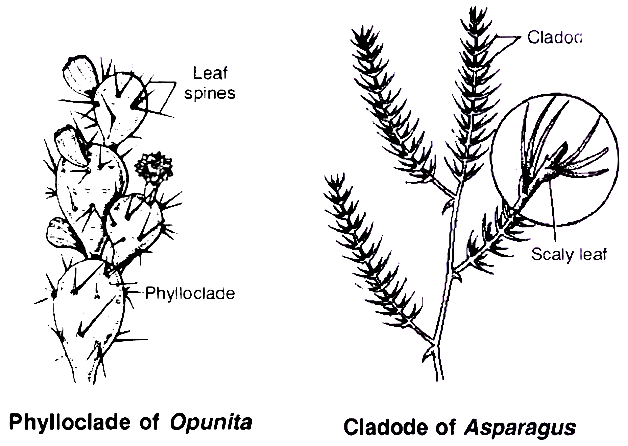
 (e) Bulbils. A condensed, axillary fleshy bud is called bulbil. It helps in vegetative reproduction. e.g., Dioscorea, Globba, Agave, Oxalis.
(e) Bulbils. A condensed, axillary fleshy bud is called bulbil. It helps in vegetative reproduction. e.g., Dioscorea, Globba, Agave, Oxalis.
Functions of a Stem :
1. Mechanical support
2. Conduction
These two are normal functions of any stem . Some special functions performed by stem are
3. Food Storage
4. Water Storage
5. Perennation
6. Photosynthesis
The Stern
The Stem
A stem is one of a vascular plant's main structural axes. It provides support for leaves, flowers, and fruits, distributes the water and dissolved chemicals between the roots and the shoots in the xylem and phloem, stores nutrients, and generates new living tissue. The stem is the section of the axis that ascends and bears branches, leaves, flowers, and fruits. It grows from the plumule of a sprouting seed's embryo. Nodes and internodes are found on the stem. Nodes are the parts of the stem where leaves are born, whereas internodes are the parts between two nodes. The stem produces buds that are either terminal or axillary. When young, the stem is usually green, but as it matures, it becomes woody and dark brown.
The stem's primary job is to spread out branches containing leaves, flowers, and fruits. Water, minerals, and photosynthates are all carried by it. Some stems have multiple functions, including food storage, support, protection, and vegetative propagation.
Modifications of a Stem: Stems havebeen altered to do various tasks. In potato, ginger, turmeric, zaminkand, and Colocasia, underground stems have been adapted to store food. They also serve as perennation organs, allowing them to survive in environments that are not conducive to growth. Stem tendrils, which emerge from axillary buds and are slender and spirally coiled, assist plants in climbing, such as cucumbers, pumpkins, and melons. Stem axillary buds can also be transformed into woody, straight, and pointed thorns.
Many plants, such as Citrus and Bougainvillea, have thorns. They keep animals from eating the plants. Arid-climate plants change their stems into flattened (Opuntia) or fleshy cylindrical (Euphorbia) forms.They have chlorophyll and are capable of photosynthesis.
Some plants, such as grass and strawberry, stretch underground stems to new niches, and new plants emerge as older sections die. A slender lateral branch emerges from the base of the main axis in plants like mint and jasmine, and after growing aerially for a time, arch downwards to touch the ground.
Aquatic plants like Pistia and Eichhornia have a lateral branch with short internodes and each node containing a rosette of leaves and a tuft of roots. The lateral branches of bananas, pineapples, and Chrysanthemums begin from the main stem's basal and underground portion, develop horizontally beneath the soil, and then emerge obliquely upward, giving rise to leafy shoots.
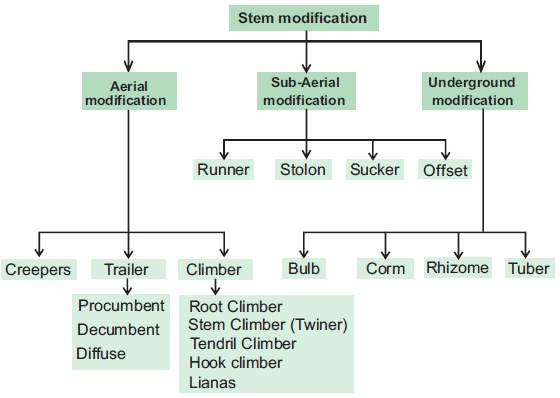
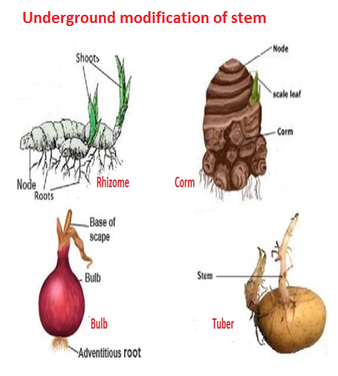

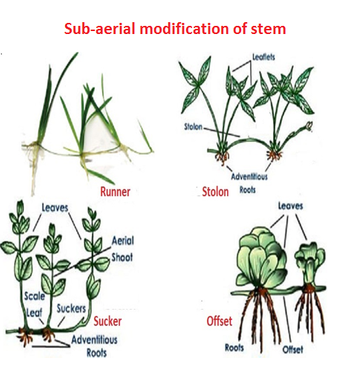
Figure 6(b): Stem modifications
The Leaf
- Books Name
- ACME SMART COACHING Biology Book
- Publication
- ACME SMART PUBLICATION
- Course
- CBSE Class 11
- Subject
- Biology
THE LEAF (PHYLLOPODIUM)
Leaves are lateral, flat, green and expanded parts of plant which arise from the nodes on the stem or branches.
Usually leaf has a bud in its axil.
The chief function of leaf is photosynthesis and transpiration.
Parts of a Leaf
A leaf consists of following three parts:
(i) Leaf base (Hypopodium)
Leaves are attached to stem by leaf base.
In some plants, leaf base becomes swollen and is called pulvinus which is responsible for sleep movement e.g., Cassia, Mimosa, bean.
In some plants, leaf base expands into sheath (sheathing leaf base), e.g., grasses and banana (monocots).
A tongue like structure is also present between leaf base and axis in grasses, called ligule.
When the leaf base partially encloses the stem, it is called semi amplexicaul e.g., Prickly poppy, Calotropis procera (Madar); if it completely encloses the stem, it is called amplexicaul e.g., Sonchus, Polygonum.
(ii) Petiole (Mesopodium)
The stalk of leaf is called petiole.
Petiole in Eichhornia becomes spongy and bulbous.
In orange (Citrus), petiole becomes winged.
Petiole is modified to tendrils in Nepenthes.
In Australian Acacia, petiole is modified into leaf like flat structure called phyllode.
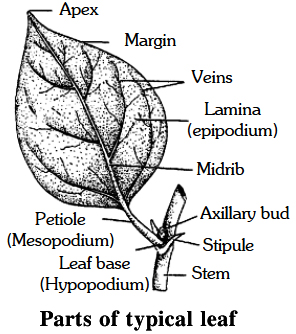
(iii) Lamina (Epipodium)
The broad, green, flat part of the leaf is called lamina ('leaf blade).
All the leaves of a plant are collectively called as phyllome.
Leaves are of the following types -
(1) Cotyledonary leaves: Embryonic or seed leaves, distinct in plants having epigeal germination.
(2) Foliage leaves: Common green, photosynthetic leaves.
(3) Scale leaves (Cataphylls) : Reduced scaly leaves.
(4) Bract leaves (Hypsophylls) : They bear flowers in their axil.
(5) Fertile leaves (Sporophylls) : They bear sporangia on their ventral surface.
(6) First leaf (Prophyll) : First few leaves different from the rest e.g., Citrus.
Prefoliation : Arrangement of leaves in bud condition. It is of two types:
(1) Ptyxis: The manner in which each individual leaf is folded or rolled in bud condition.
(2) Vernation: Arrangement of leaves with respect to each other in bud condition.
Leaf insertion
(1) Radical: Leaves borne on reduced stem, appear to arise directly from the roots e.g., radish, turnip.
(2) Cauline: Leaves found directly on the nodes of main stem e.g., maize, hollyhock.
(3) Ramal: Leaves present on the nodes of the stem branches e.g., Dalbergia, Zizyphus.
Types of Leaf
A. Simple leaf
Leaf which may be entire or incised, and the incisions do not touch the midrib e.g., mango, banyan.
B. Compound leaf
Leaf blade is incised upto midrib or petiole thus, divides it into two or more leaflets.
They are of two types :
(1) Palmately compound leaves. It has no rachis and all the leaflets are joined to a common point i.e., at the tip of petiole. They may be :
(i) Unifoliate e.g., Citrus (lemon and orange).
(ii) Bifoliate e.g., Bignonia.
(iii) Trifoliate e.g., Dolichos, Trifolium, Aegle, Butea
(iv) Quadrifoliate e.g., Marsilea, Paris
(v) Multifoliate e.g., Bombax (silk cotton tree)
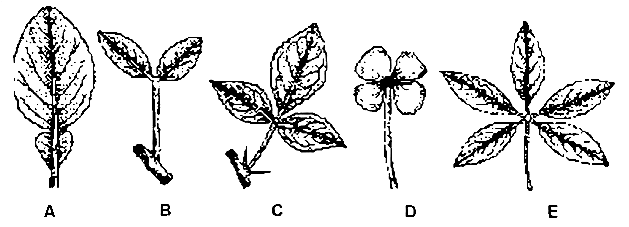
D. Quadrifoliate; E. Multifoliate (digitate)
(2) Pinnately compound leaves. Rachis bears a number of lateral leaflets. These may be :
(i) Unipinnate. Midrib of the leaf directly bears the leaflet and is now called rachis. The unipinnate compound leaf is called paripinnate when terminal leaflet is absent (leaflets are in even number) e.g., Cassia, Tamarindus or imparipinnate when terminal leaflet is present (leaflets are in odd number) e.g., Rosa, Tephrosia, Azadirachta.
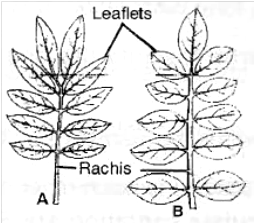
(ii) Bipinnate. Midrib produces secondary axis or branches which bear leaflets e.g., Acacia, Mimosa, Delonix.
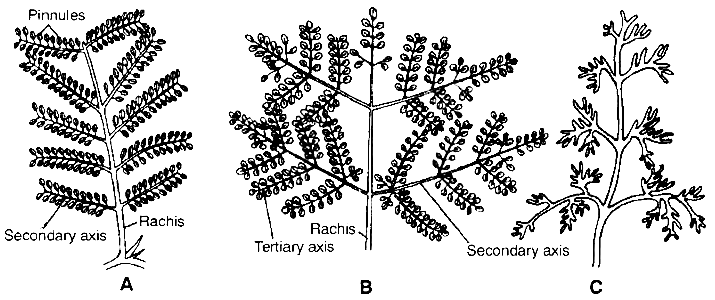
(iii) Tripinnate. Secondary axis produce tertiary axis which bear leaflets e.g., Moringa, Melia.
(iv) Decompound. Rachis is divided repeatedly without any definite pattern so that the lamina is dissected into narrow segments e.g., Carrot, Parthenium, Coriandrum.
Venation in Leaves
Arrangement of veins and the veinlets in the lamina is called venation. It is of three types :
1. Reticulate venation.
The branches of veins form a network, e.g., dicots. However there are some dicots which show parallel venation e.g., Calophylum, Eryngium and Corymbium. It may be
(i) Pinnate or unicostate : Having only one midrib which gives rise to lateral veins bearing vein lets forming reticulation e.g., Peepal , China rose.
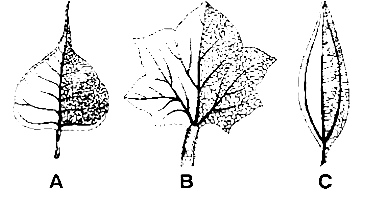
B. Palmate (multicostate) divergent; C. Palmate (multicostate) convergent
(ii) Palmate or multicostate : Many veins arise from the tip of the petiole and reach the apex or margins of the lamina. Their lateral veins form reticulation. It is of 2 types
(a) Convergent : Veins is converge towards the apex of the lamina e.g., Zizyphus and Smilax (a monocot) .
(b) Divergent: Veins diverge towards the margins e.g., Castor (Ricinus), Luffa, Vitis (grape vine), etc.
(2) Parallel venation. The veins remain parallel to each other and veinlets are inconspicuous e.g., monocots. Some monocots which show reticulate ventation are Smilax, Dioscorea, Alocasia, Colocasia.
(i) Pinnate or unicostate parallel venation - Only one principal vein (midrib) is present and lateral veins run parallel without reticulation, e.g. , Banana, Canna
(ii) Palmate or multicostate parallel venation - Many principal veins arise from the base of the lamina. They may be:
(a) Convergent e.g., Bamboo, Grasses
(b) Divergent e.g., Fan palm
(3) Furcate venation - The veins branch dichotomously but the reticulum is not formed by the finer branches e.g., Adiantum (fern), Circeaster (angiosperm).
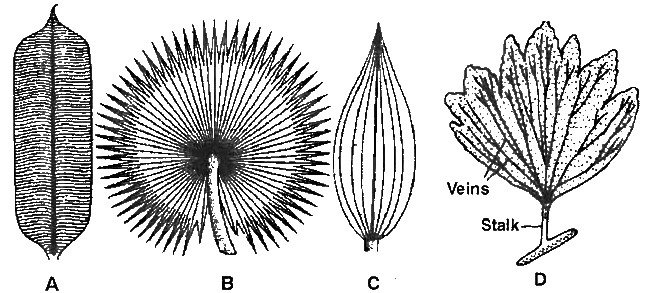
C. Palmate (multicostate) convergent D. Furcate venation
STIPULE
Small, lateral, leaf like appendage which arises in pair from the petiole axis of leaf is called stipule.
Stipule gives protection to the young axillary buds.
Leaves having these are called stipulate, while not having these are called exstipulate.
They may be of following types :
(i) Free lateral. On either side of leaf e.g., China rose, cotton.
(ii) Adnate. United with petiole e.g., Rose.
(iii) Ochreate. Form tube like covering e.g., Polygonum .
(iv) Scaly -Small membranous stipules e.g., Desmodium
(v) Axillary or intrapetiolar -Situated within the petiole towards axis e.g., Gardenia
(vi) Interpetiolar -Situated between the petioles of opposite leaves. e.g., Anthocephalus, Ixora.
(vii) Bud scales -Protect the young bud e.g., Ficus.
Modification of stipules
(1) Tendrillar stipule. In Smilax, stipule changes into tendril and helps in climbing.
(2) Foliaceous stipule. In Pisum and Lathyrus, stipules become leaf like.
(3) Spinous stipules. In Acacia and Zizyphus, stipule is modified into spines.


Types of stipules : A. Free lateral stipules, B. Adnate stipules, C. Interpetiolar stipules,
D. Intrapetiolar stipules, E. Ochreate stipules, F. Foliaceous stipules, G. Bud scales,
H. Tendrillar stipules, I. Spiny stipules
Phyllotaxy
It is the mode of arrangement of leaves on the stem or its branches. It is of following types :
(1) Alternate. Single leaf arising at each node, e.g., Mustard.
(2) Opposite. Leaves occurring in pairs at the node. They may be :
(a) Decussate. Leaves that stand at right angle to upper or lower pair of leaves at nodes, e.g., Calotropis, Sacred basil, Zinnia.
(b) Superimposed. Successive pair of leaves stand directly over a pair in the same plane, e.g., Psidium (Guava), Syzygium (Jamun), Quisqualis.
(3) Whorled. More than two leaves at each node, e.g., Nerium, Alstonia.
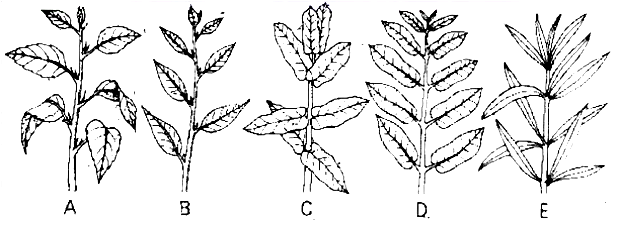
D. Opposite superimposed; E. Whorled
 Modification of Leaves
Modification of Leaves
(1) Storage leaves - e.g., Members of family Crassulaceae have thick succulent leaves which store water (hydrophillic colloids). Such storage leaves prevent the leaf against desiccation e.g., Bryophyllum.
(2) Leaf tendrils : These coil around the support and help the plant to climb.
(3) Spines: e.g. , Opuntia, Berberis . This is a xerophytic adaptation, as spines reduce transpiration loss, besides it helps to protect the plant from grazing animals.
(4) Phyllode: e.g., Acacia auriculiformis (Australian acacia). Here, the leaflets fall off early and petiole becomes flattened to function as leaf. This is also a xerophytic adaptation.
(5) Insect catching leaves - e.g., Nepenthes, Drosera, Utricularia, etc.
(6) Scale leaves -Small dry membranous, brownish leaves, e.g., Casuarina, Ruscus.
(7) Coloured leaves - Leaves near inflorescence are brightly coloured to attract the insects, e.g., Euphorbia pulcherrima (Poinsettia).
The Leaf
The Leaf
The organ of plant that generates the major lateral appendage on the stem of vascular plants is referred to as a leaf. The leaf is a lateral, flattened structure that grows from the stem. It grows at the node and produces a bud in the axil. A branch arises from the axillary bud. Shoot apical meristems give rise to leaves, which are organized in an acropetal order. They are the most essential photosynthetic vegetative organs. It's also known as the plant's kitchen or food factory. This is due to the fact that they are the primary organ responsible for photosynthesis, which is how the plant obtains its energy or food. The presence of chlorophyll gives them their green color.
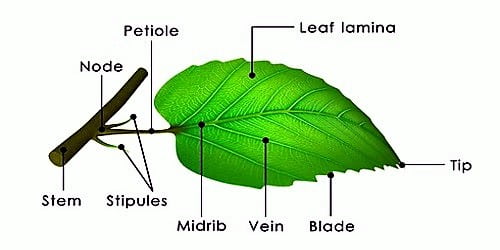
The leaf base, petiole, and lamina are the three main sections of a normal leaf. The leaf base connects the leaf to the stem, while stipules are two lateral tiny leaf-like structures. In monocotyledons, the leaf base develops into a sheath that partially or completely covers the stem. The pulvinus occurs when the leaf base of some leguminous plants becomes inflated. The petiole aids in keeping the blade lit. Leaf-blades flap in the breeze, cooling the leaf and delivering fresh air to the surface, thanks to long thin flexible petioles. The leaf blade, or lamina, is the extended green section of the leaf with veins and veinlets. There is frequently a conspicuous middle vein, referred to as the midrib.Veins give the leaf blade structure and serve as routes for water, minerals, and food components. The shape, edge, apex, surface, and extent of lamina incision vary amongst leaves.
Venation: Venation is the arrangement of veins and veinlets in the lamina of a leaf. The venation is called reticulate when the veinlets create a network. Examples: Hibiscus, papaya, leaves of Tulsi, Coriander, China Rose, and Mangifera. A type of reticulate venation pattern in which the secondary veins run parallel to each other from the midrib toward the margin is called pinnate venation. Examples include Alder, Chestnut, and Oak. Palmate is a venation pattern in which several main veins radiate outward from the base of the leaf. Examples are, Maple, Tulip etc. The venation is called parallel when the veins inside a lamina run parallel to one other. Example: banana, grass, and wheat. Most dicotyledonous plants have reticulate venation on their leaves, but most monocotyledons have parallel venation.A vascular arrangement in leaves such that the veins are forked, with each vein dividing at intervals into smaller veins of approximately equal size is called Dichotomous venation, for example, Ginkgo biloba.
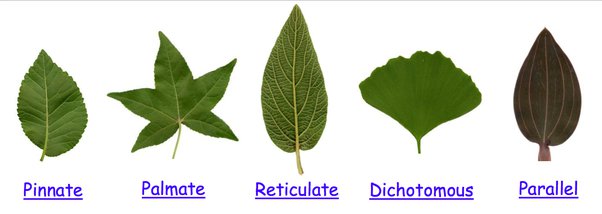
Types of leaves:
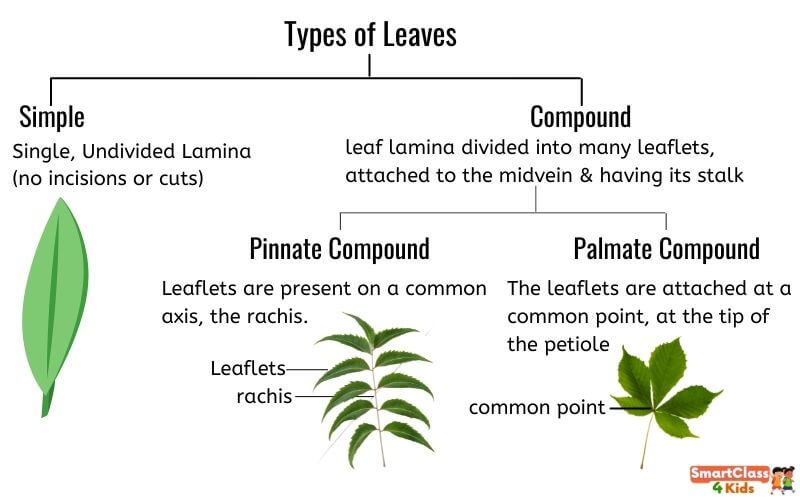
Different types of leaves are described below:
a) Simple leaf: When a leaf's lamina is complete or when the incisions do not touch the midrib, it is considered to be simple.
b) Compound Leaf: The leaf is considered compound when the incisions of the lamina go up to the midrib, breaking it into a number of leaflets. There are two types of compound leaves. As in neem, a pinnatelycompound leaf has a number of leaflets on a common axis, the rachis, which represents the leaf's midrib. The leaflets of palmately compound leaves are joined at a common point, the tip of the petiole, as seen in the silk cotton plant.
In both simple and compound leaves, a bud can be found in the axil of the petiole, but not in the axil of the leaflets.
Phyllotaxy:
The pattern of leaf arrangement on the stem or branch is known as Phyllotaxy. There are three varieties of this: alternate, opposite, and whorled. In alternate phyllotaxy, a single leaf emerges alternately at each node, as seen in China rose, mustard, and sunflower plants. As in Calotropis and guava plants, a pair of leaves emerges at each node and lies opposite each other. This is the opposite phyllotaxy. It is called whorled when more than two leaves emerge from a node and form a whorl, as in Alstonia.
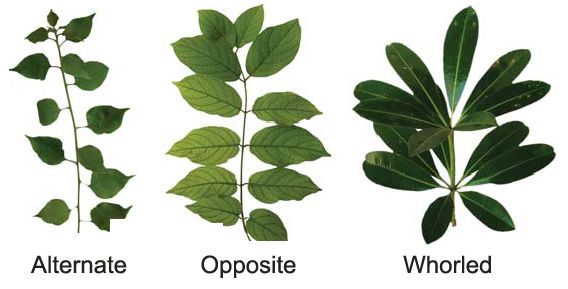
Modifications of a leaf:
Additional to photosynthesis, leaves are frequently adapted to fulfill other purposes. They are transformed into tendrils in peas for climbing and spines in cacti for defence. Onion and garlic leaves have fleshy leaves that store nourishment. The leaves of some plants, such as Australian acacia, are tiny and short-lived. These plants' petioles swell, turn green, and synthesize nourishment. Certain insectivorous plants, such as pitcher plants and venus fly traps, have modified leaves as well.
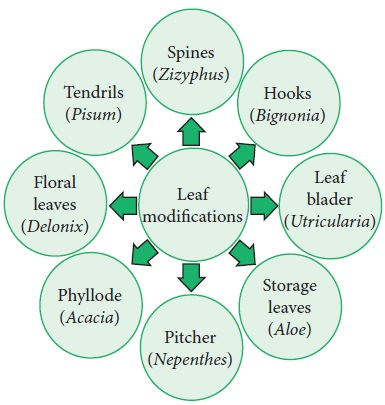
The Inflorescence
- Books Name
- ACME SMART COACHING Biology Book
- Publication
- ACME SMART PUBLICATION
- Course
- CBSE Class 11
- Subject
- Biology
THE INFLORESCENCE
The arrangement of flowers on the floaral axis (peduncle) is called inflorescence. It is basically of two types -Racemose and Cymose.
A. Racemose (Indefinite)
Main axis of inflorescence does not end in a flower but continues to grow.
The development of flowers is acropetal.
The opening of flowers is centripetal.
Concept Builder
Racemose inflorescence is of following types :
(i) Raceme. Peduncle has bisexual and pedicellate flowers arranged acropetally, e.g., Larkspur, radish.
(ii) Panicle. Peduncle branched and branches have pedicellate flowers, e.g. , Gulmohr, Rhus.
(iii) Spike. Peduncle has bisexual and sessile flowers, e.g. , Achyranthes, Adhathoda.
(iv) Spikelet. It is a small, special spike. Flowers are produced in the axil of fertile bracts called lemma, e.g., wheat, grasses (Poaceae).
(v) Catkin. It is pendulous spike in leaf axis which bears unisexual flowers, e.g., Morus, Birch, Oak, Acalypha.
(vi) Spadix. It is spike with fleshy axis and having both male and female flowers. It is surrounded by large coloured bracts called spathe, e.g., Musa, Palm, Colocasia, Alocasia (characteristically found in monocots).
(vii) Corymb. The main axis is short. Lower flowers have long pedicels than upper ones so that all the flowers are brought more or less to the same level, e.g., Iberis, Capsella.
Compound corymb, e.g., Cauliflower. Corymbose raceme is found in mustard.
(viii) Umbel. The main axis is reduced very much and all flowers appear to be arising from the same point. At the base of flowers, cluster of bracts form an involucre, e.g., Hydrocotyle. Scapigerous umbel is found in onion.
Compound umbel e.g., Coriander.
(ix) Capitulum or head. Main axis becomes flat and called receptacle. It bears many sessile and small florets. Peripheral florets called ray florets are pistillate or neuter and zygomorphic, whereas disc florets are bisexual and actinomorphic e.g., Sunflower, Zinnia, Cosmos (Asteraceae).
B. Cymose (Definite)
Main axis terminates in a flower. The development of flowers is basipetal and opening of flowers is centrifugal.
Concept Builder
Cymose inflorescence is of following types :
(i) Monochasial or uniparous cyme. A single lateral branch arises from a cymose axis which terminates in a flower. It is of two types:
(a) Helicoid cyme. When the lateral axis develop successively on the same side, forming a helix e.g., Atropa, Datura, Begonia, Heliotropium .
(b) Scorpioid cyme. Lateral branches (successive flowers) arise alternately on left and right sides (in zig zag manner), e.g., Ranunculus.
(ii) Dichasial or biparous cyme. Two lateral branches arise at a time from a cymose axis, which end into flower, e.g., Dianthus, Nyctanthes.
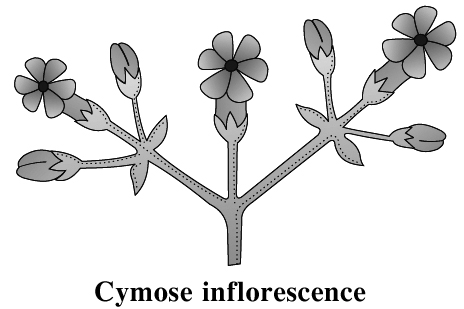
(iii) Polychasial or multiparous cyme. More than two lateral branches arise at a time from a cymose axis and all of them end into flowers, e.g., Hamelia, Calotropis.
(iv) Capitate. Large number of sessile flowers grow on a suppressed axis to form a globose structure. e.g., Acacia, Mimosa, Anthocephalus.
Special inflorescences : These are of following types :
(i) Verticillaster. A cluster of sessile or subsessile flowers borne on a dichasial cyme ending in monochasial cyme (scorploid) in the form of condensed whorl on either side of the node. e.g., Ocimum (Tulsi), Salvia (Lamiaceae).
(ii) Cyathium. It looks like a single flower. A cup shaped involucre formed by bracts encloses a single female flower and a number of male flowers. Each male flower is represented by single stamen, while a single pistil represents a female flower e.g., Poinsettia (Euphorbia pulcherrima), Pedilanthus .
(iii) Hypanthodium. Fleshy receptacle forming a hollow cavity with an apical opening called ostiole. The flowers are developed on inner wall of the hollow cavity. The male flowers are situated at the top near the opening, at the bottom are situated the female flowers with long styles and in between both are situated short styled gall flowers which are sterile. e.g., Ficus (Banyan, Fig, Gular).
(iv) Coenanthium. In Dorstenia, the receptacle becomes saucer shaped and its margins are slightly curved. The arrangement of florets is similar to hypanthodium.
The Inflorescence
Inflorescence
The inflorescence is the arrangement of flowers along the floral axis. A flower is a modified shoot in which the apical meristem of the shoot transforms into the floral meristem. The axis becomes condensed as the internodes do not lengthen. Instead of leaves, the apex produces several types of floral appendages at successive nodes. The transformation of a shoot tip into bloom is always solitary. Two basic forms of inflorescences are described based on whether the apex develops into a flower or continues to grow:
1. Racemose. The primary axis of racemose inflorescences continues to grow, but the flowers are carried laterally in acropetal succession. Younger flowers are present at the tip while older flowers are arranged at the base of this inflorescence. Example: Mustard, Snapdragon, Gulmohar, Wheat, Barley, Parsley.
2. Cymose: The primary axis of a cymose inflorescence terminates in a flower, limiting its expansion.The flowers are borne in a basipetal order. Younger flowers are present at the base of the inflorescence, while older flowers are present at the top. The cymose inflorescence is present in plants like Solanum nigrum, Drosera, Begonia, Ranunculus, Jasmine, Calotropis, etc.
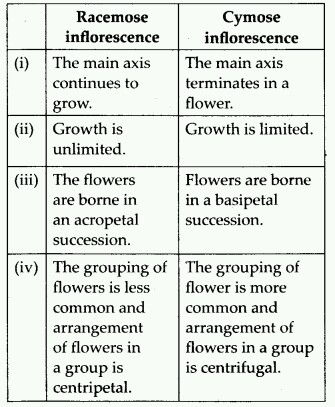
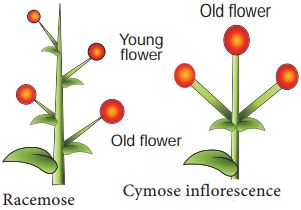
The Flower
- Books Name
- ACME SMART COACHING Biology Book
- Publication
- ACME SMART PUBLICATION
- Course
- CBSE Class 11
- Subject
- Biology
THE FLOWER
Flower is defined as a highly condensed and modified reproductive shoot.
Instead of leaves the apex produces different kinds of floral appendages laterally at successive nodes.
Following points can be mentioned to justify that flower is a modified shoot:
(1) Calyx, corolla, androecium and gynoecium represent four whorls of sterile and fertile leaf modifications borne at different nodes.
Sometimes, internode between calyx and corolla becomes elongated and called as anthophore, e.g., Silene Dianthus.
The internode between corolla and androecium is known as androphore, e.g., Passiflora.
The internode between androecium and gynoecium is called as gynophore e.g., Capparis.
When androphore and gynophore both are present in the same flower they are jointly termed as gynandrophore e.g., Cleome gynandra.
The prolongation of thalamus beyond carpel is known as carpophore, e.g., Coriandrum, Foeniculum.
(2) In Mussaenda, one sepal enlarges to form leafy structure (foliaceous sepal).
(3) Sometimes, floral bud gets transformed into vegetative bud or bulbil. e.g., Agave.
Concept Builder
Terminology used w.r.t. flower
(i) Complete flower: All four whorls (calyx, corolla, androecium and gynoecium) are present.
(ii) Incomplete flower: Flower with anyone of the four whorls missing.
(iii) Bisexual flower: Both gynoecium and androecium are present in the same flower.
(iv) Unisexual flower: Either androecium (staminate flower) or gynoecium (pistillate flower) is present in the flower.
(v) Monoecious plant: When both male and female flowers are present on the same plant e.g., Cocos, Ricinus, Zea, Colocasia, Acalypha.
(vi) Dioecious plant: When male and female flowers are present on separate plants e.g., Mulberry, Papaya.
(vii) Polygamous plant: When unisexual (male or female) , bisexual and neuter flowers are present on the same plant e.g., Polygonum, Mango.
(viii) Achlamydeous flower: Flowers are naked i.e., without sepals and petals e.g., Piperaceae.
(ix) Monochlamydeous flower :Only one whorl is present (perianth) e.g., Polygonaceae, Liliaceae.
(x) Dichlamydeous flower: Both whorls (calyx and corolla) present in a flower e.g., most of the flowers.
(xi) Hemicyclic or spirocyclic flowers: Some of the floral parts form circles and some are spirally arranged e.g., Ranunculaceae.
(xii) Cauliflory: Production of flowers on old stem from dormant buds e.g., Artocarpus, Ficus.
Symmetry of Flower
(i) Actinomorphic flower. When a flower can be divided into two equal halves by many vertical sections passing through the centre. e.g., Cruciferae, Malvaceae.
(ii) Zygomorphic flower. When a flower can be divided into two equal halves by only one vertical section passing through the centre. e.g., Pea.
Position of Floral Parts on Thalamus
(i) Hypogyny. Ovary is at the top and separable from thalamus. Such flowers are called hypogynous and ovary is said to be superior. e.g. , Malva, Brassica.
(ii) Perigyny. Ovary is situated in centre and other parts of the flower are located on the rim of thalamus, almost at the same level. Ovary is half superior, half inferior. e.g., Rose.
(iii) Epigyny. Calyx and corolla arise from upper side of ovary. Ovary is completely surrounded by and fused with thalamus. Ovary is called inferior and flower is said to be epigynous e.g., Aster, Luffa.
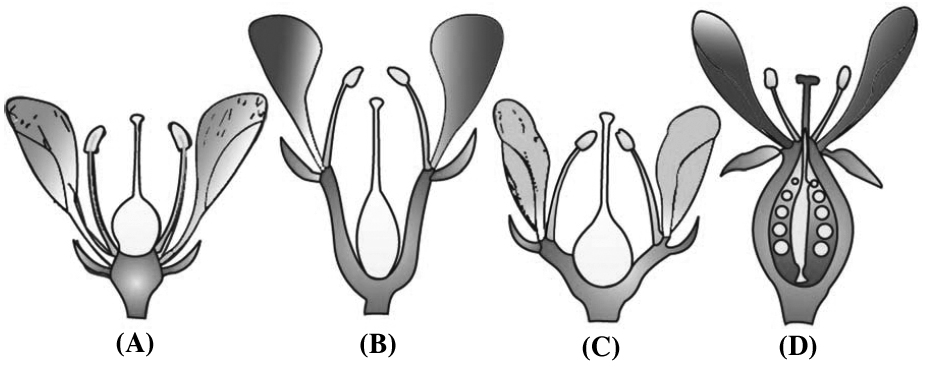
(A) Hypogynous, (B) and (C) Perigynous, (D) Epigynous
Bracts
Bracts are specialized leaves bearing flower in the axil. They are of following types:
(i) Petaloid bracts. Bracts look like petals (brightly coloured). e.g., Bougainvillea.
(ii) Spathy bract. This is large bract enclosing an inflorescence. e.g., Banana, Maize, Palms.
(iii) Foliaceous bracts. Bracts are leaf like in appearance e.g., Adhatoda, Gynandropsis.
(iv) Involucre. They are green coloured and in one or more whorls around or below the entire inflorescence. e.g., Sunflower, Coriander.
(v) Glumes. These are small, dry, scaly bracts found in spikelet of Gramineae. e.g., Wheat.
All floral whorls are described respectively :
A. Calyx
Outermost whorl of a flower is called calyx. It is the non-essential whorl and consists of sepals. Sepals may be free (polysepalous) or fused (gamosepalous). Sepals are modified as follows :
(i) Pappus. Sepals are modified into persistent hairy structures called pappus which help in dispersal of fruits. e.g., Sunflower, Sonchus. (Asteraceae) .
(ii) Leafy. In Mussaenda, one sepal gets modified into large leaf like white structure.
(iii) Spinous. In Trapa , the calyx is persistent and modified into two spines.
B. Corolla
It is second whorl of flower and consists of a number of petals which are usually bright coloured. The petals may be fused (gamopetalous) or free (polypetalous).
Concept Builder
Various forms of petals are :
(i) Cruciform. Four petals arranged like a cross e.g. , members of Brassicaceae.
(ii) Papilionaceous. Number of petals is five with largest petal standard or vexillum, enclosing two lateral petals called wings or alae which are free, these in turn enclose the inner most petals called keel or carina (united petals) , e.g. , Pea.
(iii) Caryophyllaceous. Five, free, long, clawed corolla, with limbs spreading at right angles to claws. e.g., Dianthus.
(iv) Tubular. Petals are like a tube, e.g. , disc florets of sunflower.
(v) Campanulate or bell shaped. Petals are like a bell, e.g., Physalis.
(vi) Infundibuliform or funnel shaped. Petals are like funnel, e.g., Datura .
(vii) Bilabiate (two lipped). Upper and lower lips are formed by fusion of petals, e.g., Salvia, Ocimum.
(viii) Ligulate or strap shaped. Gamopetalous petals forming tongue like structure, e.g., Ray florets of Sunflower.
(ix) Personate. Corolla is bilabiate, but the lips are so near to each other as to close the mouth of the corolla, e.g., Antirrhinum.
Aestivation
Arrangement of floral parts in a floral bud with respect to the other members of the same whorl is known as aestivation. It may be of following types.
(i) Valvate. When sepals or petals lie very close to each other, without overlapping e.g., Mustard.
(ii) Twisted or contorted. When one margin of the sepal or petal overlaps the margin of next and other margin is overlapped by the third one. e.g., China rose.
(iii) Imbricate. When both margins of one of the petals are covered by others and both margins of another one are external and of the remaining partly internal, partly external. e.g., Cassia, Caesalpinia.
(iv) Quincuncial. When two petals are inner, two are outer and one is partly outer and partly inner e.g., Ranunculus.
(v) Vexillary. The posterior one is largest and almost covers the two lateral petals and the latter in turn nearly overlap the two anterior petals, e.g. , Pea (Papilionaceae).
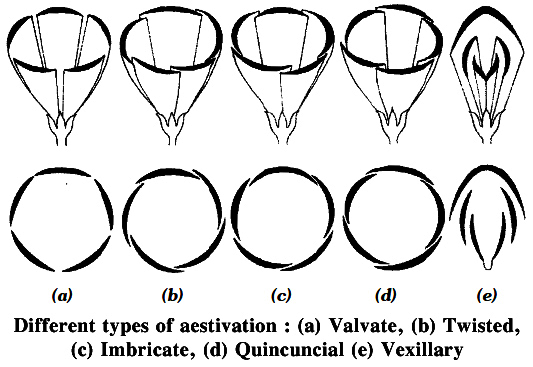
C. Androecium
Androecium is the third and male whorl of the flower and is made up of one or more stamens (equivalent to microsporophylls).
Each stamen consists of filament, anther and connective. The two lobed anther is called bithecous anther e.g., Pea.
The anther with one lobe is called monothecous anther. e.g., members of Malvaceae.
When stamens are free from each other the condition is called polyandrous, e.g., lily, mustard.
A sterile stamen is called staminode.
Cohesion of Stamens
Fusion of stamens among themselves is called cohesion.
(i) Monadelphous. Stamens may be united by means of their filaments in one bundle with free anthers. e.g., China rose, lady's finger, cotton (Malvaceae).
(ii) Diadelphous. When the filaments are united into two bundles and the anthers remain free, e.g., Pea, bean, gram (Papilionaceae).
(iii) Polyadelphous. When the filaments are united into more than two bundles but anthers are free e.g., Castor (Euphorbiaceae), Lemon (Rutaceae)
(iv) Syngenesious. When anthers are united but the filaments are free, e.g., Sunflower (Compositae).
(v) Synandrous. When anthers as well as filaments of stamens are united throughout their whole length, e.g. , members of Cucurbitaceae.
Adhesion of Stamens
Fusion of stamens with other floral parts.
(i) Epipetalous. When stamens are united to the petals. e.g., China rose, Solanum, Sunflower.
(ii) Episepalous. When stamens are united to sepals. e.g., Verbena.
(iii) Epiphyllous (Epitepalous). When stamens are united to perianth (Tepal). e.g., members of Liliaceae.
(iv) Gynandrous. When stamens are attached to gynoecium (carpel) either throughout their whole length or by their anthers only, e.g., Calotropis, (forming gynostegium).
Length and arrangement of Stamens
(i) Didynamous. 4 stamens, two outer small and two inner long, e.g., Ocimum, Salvia (Lamiaceae).
(ii) Tetradynamous. 6 stamens, two outer small and four inner long, e.g., Mustard, Radish (Brassicaceae).
(iii) Heterostemony. Stamens are of different lengths, e.g., Cassia.
Concept Builder
Obdiplostemonous condition:
Two whorls of stamens, outer lying opposite to the petals (anti-petalous) and inner whorl lying opposite to sepals (anti-sepalous), e.g., Stellaria, Spergula and members of Rutaceae.
Diplostemonous condition:
Two whorls of stamens, outer whorl lying opposite to sepals (antisepalous) and inner whorl lying opposite to petals (antipetalous), e.g., Cassia.
D. Gynoecium
It is the female part of flower comprising of carpels bearing ovules.
It consists of ovary, style and stigma.
The gynoecium may be monocarpellary (one carpel) or polycarpellary (many carpels).
Cohesion of Carpels
(i) Apocarpous. Carpels are free (no cohesion), e.g., Ranunculaceae.
(ii) Syncarpous. Carpels more than two and fused, e.g., most of the plants.
Number of locules. Ovary has locules or chambers having ovules and may be unilocular, bilocular, trilocular, tetralocular or pentalocular (multilocular).
Placentation
The arrangement of ovules on placenta within the ovary is called placentation.
It is of following types:
(i) Marginal. Placenta developing along the junction of the two margins of the carpel in one chambered ovary. It is characteristic feature of family Leguminosae. e.g., Pea, gram.
(ii) Axile. The ovary is two to many chambered and placenta bearing ovules develop from the central axis e.g., Tomato, orange, cotton, china rose, lily. (A)
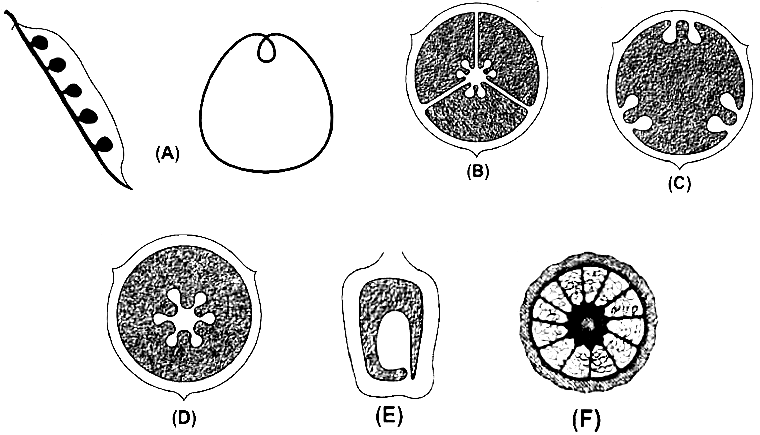
(E) Basal; (F) Superficial
(iii) Parietal. Ovary is one chambered and the placenta bearing the ovules develop close to the inner wall of the ovary, e.g., Mustard, radish, cucumber, Argemone.
(iv) Free central. Ovary is one chambered and the placenta bearing the ovules develop all round the central axis. Septa are absent, e.g., Dianthus, Stellaria.
(v) Basal. Ovary is unilocular and the placenta develops at the base of ovary on thalamus and bears a single ovule, e.g. , Wheat, maize, Aster, Zinnia, sunflower. It is most advanced.
(vi) Superficial. Ovary is multilocular with numerous carpels as in axile type of placentation but placenta develops all round the inner surface of the partition wall, e.g., Water lily. It is most primitive.
Style. It is generally terminal but may be lateral, e.g., Poaceae, mango.
Gynobasic style arises from base of the ovary, e.g., Lamiaceae.
The Flower
The Flower
In angiosperms, the flower is the reproductive unit. It's designed to be used for sexual reproduction. On the swollen end of the stalk or pedicel, called the thalamus or receptacle, a typical flower has four different kinds of whorls placed sequentially. Calyx, corolla, androecium, and gynoecium are the four flower parts. Androecium and gynoecium are reproductive organs, while calyx and corolla are accessory organs. The calyx and corolla of some flowers, such as lilies, are not distinct and are referred to as perianth. A flower is bisexual if it has both androecium and gynoecium. Unisexual flowers are those that have only stamens or carpels.
The flower can be actinomorphic (radial symmetry) or zygomorphic (bilateral symmetry). Flowers that have multiple lines of symmetry (like a starfish) are radially symmetrical, also called actinomorphic. Flowers with only a single line of symmetry are bilaterally symmetrical, also called zygomorphic. Actinomorphic flowers, such as mustard, datura, and chilli, can be divided into two equal radial halves in any radial plane running through the centre. It is zygomorphic when it can be separated into two comparable halves only in one vertical plane, as in pea, Gulmohar, bean, and Cassia. If a flower, like canna, cannot be divided into two comparable halves by any vertical plane going through the centre, it is asymmetric (irregular).
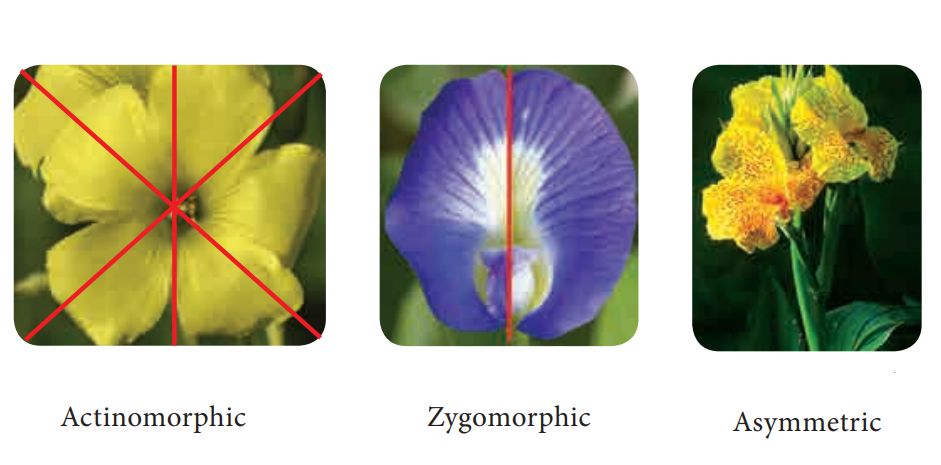
Trimerous, tetramerous, and pentamerous flowers have floral appendages in multiples of 3, 4, and 5, respectively. Bracteate flowers have a shortened leaf at the base of the pedicel, whereas ebracteate flowers do not have one. Flowers are classified as hypogynous, perigynous, or epigynous based on the position of the calyx, corolla, and androecium in relation to the ovary on the thalamus. The gynoecium is at the top of the hypogynous flower, with the other sections below it. Such flowers, such as mustard, China rose, and brinjal are said to have superior ovaries. If the gynoecium is in the center and the other parts of the flower are virtually at the same level as the thalamus rim, the flower is said to be perigynous.Plum, rose, and peach, for example, have a half inferior ovary. The thalamus margin develops upward in epigynous flowers, entirely enclosing and fusing with the ovary; the other parts of the flower ascend above the ovary. As a result, the ovary is reported to be inferior in guava and cucumber flowers, as well as sunflower ray florets.

Parts of a flower include:

Calyx: The calyx is the flower's outermost whorl, and the sepals are its members. Sepals are green, leaf-like structures that protect the flower at the bud stage. The calyx can be gamosepalous (sepals together) or polysepalous (sepals apart) (sepals free).
Corolla: Petals make up the corolla. Petals are typically vividly coloured to attract pollinating insects. Corollas can be gamopetalous (petals joined) or polypetalous, just as the calyx (petals free). Plants have a wide range of corolla shapes and colours. Tubular, bell-shaped, funnel-shaped, or wheel-shaped corollas are all possible.
Aestivation refers to the way sepals or petals in a floral bud are arranged in relation to the other members of the same whorl. Valvate, twisted, imbricate, and vexillary aestivation are the most common kinds. Valvate describes a whorl in which the sepals or petals only touch at the margin, without overlapping, as in Calotropis. Twisted means that one appendage's edge overlaps the next and so on, as in the china rose, lady's finger, and cotton. Imbricate aestivation occurs when the borders of sepals or petals overlap but not in any specific direction, as in Cassia and Gulmohar.The largest (standard) petal overlaps the two lateral petals (wings), which overlap the two smallest anterior petals (keel) in pea and bean flowers; this type of aestivation is known as vexillary or papilionaceous.
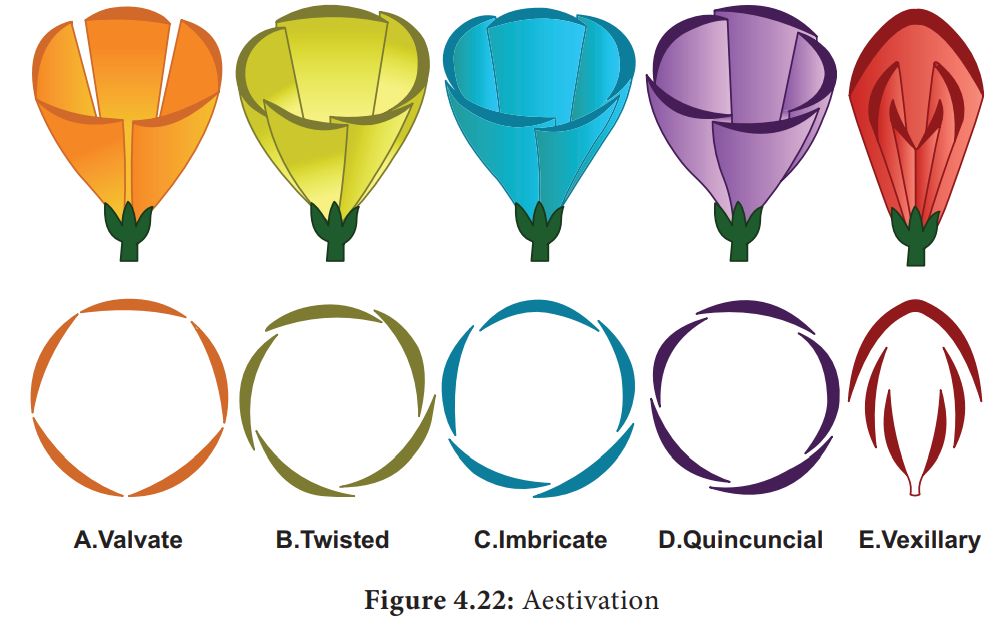
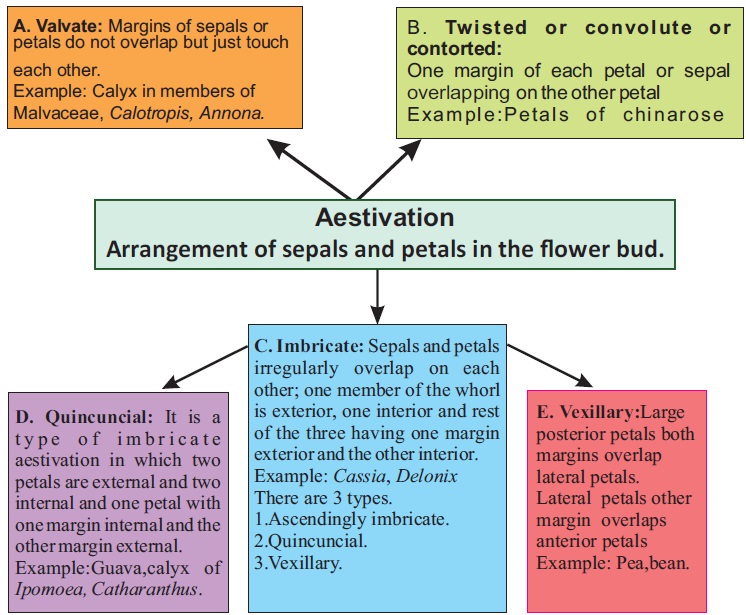
Androecium: Stamens make up the androecium. A stalk or filament and an anther make up each stamen, which represents the male reproductive organ. Each anther is normally bilobed, with two pollen-sac chambers in each lobe. Pollen grains are manufactured in pollen sacs. The staminode is a sterile stamen. Flower stamens can be joined to other components of the flower, such as petals, or to each other. Stamens are epipetalous when attached to the petals, as in brinjal, or epiphyllous when attached to the perianth, as in lily flowers. A flower's stamens can either remain free (polyandrous) or be joined to varying degrees.The stamens can be grouped into a single bunch or bundle (monoadelphous), two bundles (diadelphous), or more than two bundles (polyadelphous) as in China rose. Within a flower, filament length can vary, as in the case of Salvia and mustard.
Gynoecium: The female reproductive component of the flower is the gynoecium, which is made up of one or more carpels. The stigma, style, and ovary are the three sections of a carpel. The expanded basal portion of the ovary is where the elongated tube, the style, is located. The ovary is linked to the stigma by the style. The stigma is the receptive surface for pollen grains and is usually found at the tip of the style. One or more ovules are linked to a flattened, cushion-like placenta in each ovary. When more than one carpel is present, it is referred to as apocarpous as in lotus and rose. When carpels fuse, as in mustard and tomato, they are called syncarpous.The ovules develop into seeds after fertilization, and the ovary matures into a fruit.
Placentation is defined as the placement of ovules within the ovary. There are several varieties of placentation: marginal, axile, parietal, basal, central, and free central. The placenta forms a ridge along the ventral suture of the ovary in marginal placentation, and the ovules are carried in two rows on this ridge, as in pea. The placenta is considered to be axile when the placenta is axial and the ovules are linked to it in a multilocular ovary, as in the China rose, tomato, and lemon. The ovules develop on the inner wall of the ovary or on the peripheral region in parietal placentation. In mustard and Argemone, the ovary is one-chambered but becomes two-chambered due to the creation of the false septum.The placentation is called free central when the ovules are borne on the central axis and the septa are missing, as in Dianthus and Primrose. As in sunflower and marigold, the placenta develops at the base of the ovary and is linked to a single ovule.
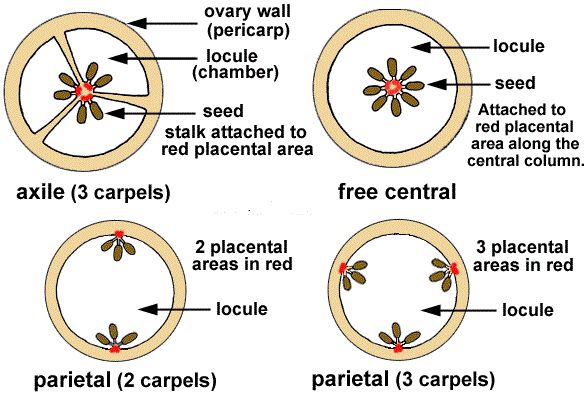
The Fruit
- Books Name
- ACME SMART COACHING Biology Book
- Publication
- ACME SMART PUBLICATION
- Course
- CBSE Class 11
- Subject
- Biology
THE FRUITS
Fertilized and ripened ovary is fruit.
A fruit consists of (i) Pericarp (fruit wall)-developing from wall of ovary and may differentiated into epicarp, mesocarp and endocarp. (ii) Seeds-developing from ovules.
In some plants ovary grows into fruit without fertilization, such fruits are called parthenocarpic fruits.
They are seedless e.g., Banana, grapes, oranges.
The fruit which develops from ovary is called true fruit.
Most of the fruits are true fruits.
If any floral part other than ovary takes part in fruit formation , it is called false fruit (pseudocarp). e.g., Apple, Pear.
Schematic presentation of different kinds of fruits
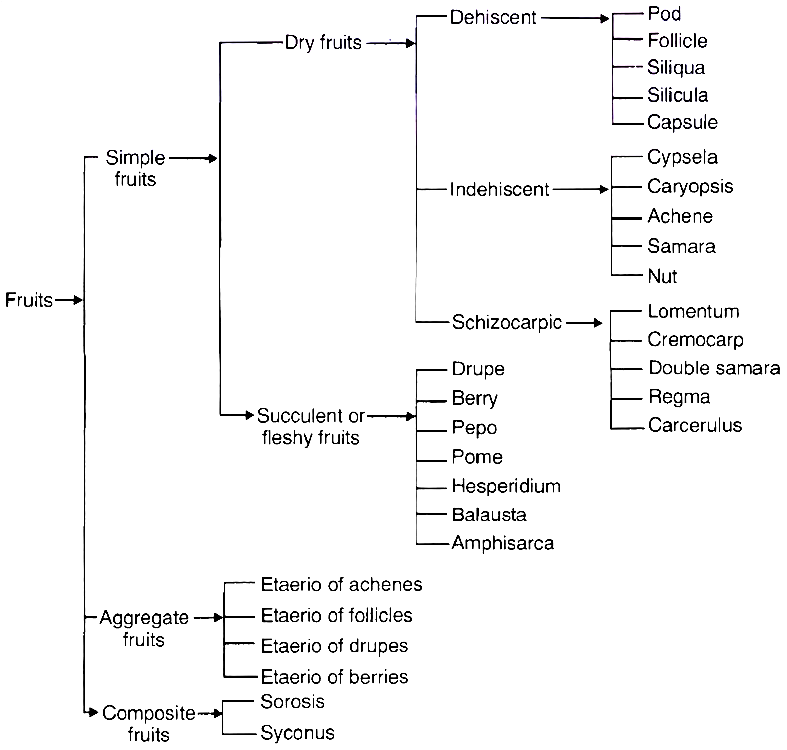
Types of Fruits
1. Simple fruits
Fruit developing from the syncarpous ovary of the single flower with or without accessory parts is called simple fruit. Simple fruits are of following types:
A. Dry indehiscent fruits. They do not split or burst. Seeds are liberated only by the decomposition or destruction of pericarp.
Concept Builder
(i) Caryopsis. Develops from monocarpellary, unilocular ovary. Fruit wall or pericarp completely fused with seed coat. e.g., wheat, maize, rice (Graminae).
(ii) Achene. It develops from monocapellary, unilocular ovary. Fruit wall (pericarp) is not completely attached with seed coat (as that of caryopsis), e.g., Mirabilis.
(iii) Cypsela. Develops from bicarpellary, unilocular and inferior ovary. Calyx is hair like and called pappus which helps in dispersal of fruits (seeds), e.g., Sunflower, Sonchus, Zinnia, Taraxacum. It is characteristic fruit of family Compositae (Asteraceae).
(iv) Samara. Develops from superior ovary. Fruits are winged and wings develop from pericarp, e.g., Holoptelea, Dioscorea, Hiptage.
If wings in fruits develop from sepals they are called samaroid, e.g., Shorea (Sal), Dipterocarpus, Hopea.
(v) Nut. Develops from polycarpellary superior ovary. Pericap is hard (stony) and sometimes woody, e.g., Anacardium (cashew nut), Litchi (marking nut), Trapa (water chestnut) and Quercus (oak).
B. Dry dehiscent fruits. These fruits burst automatically and discharge their seeds.
Concept Builder
(i) Legume or pod. Dry, one chambered fruit developing from a superior and monocarpellary ovary. Mature fruit dehisces by both sutures or margins, e.g., Gram, lentil, pea.
(ii) Follicle. Develops from bicarpellary, ovary. Mature fruit dehisces by one suture only, e.g., Delphinium, Catharanthus.
(iii) Siliqua. Develops from bicarpellary, unilocular ovary with parietal placentation, dehiscence of fruits occur by both the halves from base to apex, e.g., Mustard, radish. This is characteristic fruit of family Cruciferae or Brassicaceae.
(iv) Silicula. A short, broad, flat siliqua with few seeds is known as silicula. e.g., Iberis, Capsella.
(v) Capsule. Develops from multicarpellary, syncarpous ovary. Dehiscence occurs by many ways.
(a) By Pores. Porocidal, e.g., Opium (Poppy), Argemone.
(b) By locules or valves. Loculicidal, e.g., Cotton.
(c) By Septa. Septicidal, e.g., Linseed.
(d) Septa breakdown into fragments. Septifragal, e.g., Datura.
C. Dry schizocarpic fruits. They are intermediate between dehiscent and indehiscent fruits. On maturation they break into a number of indehiscent parts (mericarp) or dehiscent parts (cocci).
Concept Builder
(i) Lomentum. Pod is constricted or chambered between the seeds into a number of one seeded compartments, e.g., Acacia, Mimosa, Arachis, Inga dulce, Tamarindus.
(ii) Cremocarp. Develops from bicarpellary inferior ovary. Fruit splits into two indehiscent one seeded mericarps, e.g., Coriander, cumin (Umbelliferae or Apiaceae).
(iii) Regma. Develops from tricarpellary, syncarpous, trilocular, superior ovary with axile placentation. Fruits split into three one seeded dehiscent units called cocci, e.g., Euphorbia, Ricinus (castor), Geranium, Jatropa.
(iv) Double samara. Just like samara, but at maturity splits into two one seeded samaras. e.g., Acer (maple).
(v) Carcerulus. Develops from bi-or multicarpellary, superior ovary. Fruits split into two, four or more indehiscent parts e.g., Ocimum, Salvia.
D. Fleshy or succulent fruits. These are of following types:
(i) Drupe. Mostly one seeded fruits with pericarp differentiated into epicarp, mesocarp and hard and stony endocarp, e.g., Mangifera indica (Mango-epicarp forms skin, mesocarp-fleshy, juicy and edible, endocarp is hard and stony), Cocos nucifera (Coconut-Mesocarp is fibrous which is used in making coir so called as fibrous drupe), Juglans regia (walnut).
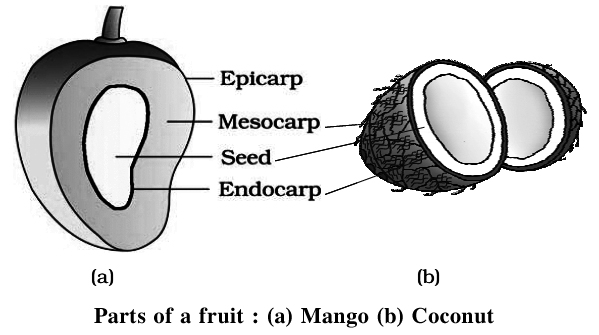
(ii) Berry. One to many seeded fruits. Epicarp forms the outer skin. Middle thick and fleshy part is called mesocarp with a membrane like endocarp, e.g., Tomato, guava, papaya, grapes, banana, brinjal, chillies. Betel nut is a one seeded berry.
(iii) Pepo (hard walled berry). Develops from tricarpellary, syncarpous, unilocular and inferior ovary. Epicarp forms skin of fruit. Mesocarp and endocarp are fleshy and edible. Sometimes, fruits are bitter in taste due to tetracyclic triterpenes e.g., Cucumber, gourd, watermelon.
(iv) Pome. Develops from syncarpous inferior ovary which is surrounded by fleshy thalamus. So, true fruit lies inside the swollen fleshy and edible thalamus. It is false fruit or pseudocarp. e.g., Apple, pear. Edible part is fleshy thalamus.
(v) Hesperidium. Develops from multicarpellary, multilocular, syncarpous, superior ovary with axile placentation. The epicarp and mesocarp fused together to form skin or rind of the fruit. Endocarp projects inwards forming a number of distinct chambers. The juicy unicellular hairs are present on the inner side of the endocarp. e.g.,Orange and all citrus fruits.
(vi) Balausta. Develops from multilocular,syncarpous, inferior ovary. Epicarp is tough and leathery. Endocarp is membranous. Seeds are irregularly distributed inside the fruit. Juicy testa of the seeds is edible. The fruit has persistent calyx e.g., pomegranate.
(vii) Amphisarca. Develops from multicarpellary, syncarpous, multilocular and superior ovary. The epicarp is hard and woody, mesocarp, endocarp and swollen placenta are fleshy and edible e.g., Aegle marmelos (wood apple or bael), Feronia limonia (Kaith or elephant apple).
2. Aggregate fruits
Aggregate fruits are formed from polycarpellary, apocarpous ovary.
Each carpel develops into a fruitlet and all fruitlets together form an aggregate fruit.
An aggregate of simple fruits borne by apocarpous ovary of a single flower is otherwise known as 'etaerio'.
Aggregate fruits are of the following types -
(i) An etaerio of achenes e.g., Strawberry, Rose, Clematis.
(ii) An etaerio of berries e.g., Artobotrys, Polyalthia, Annona (custard apple)
(iii) An etaerio of follicles e.g., Delphinium, Michelia.
(iv) An etaerio of drupes e.g., Raspberry.
3. Multiple or composite fruits
The multiple fruit develops from the entire inflorescence. These fruits are of two types :
(i) Sorosis. These fruits develop from spike, spadix or catkin inflorescence. The flowers fuse together by their sepals or perianth and the whole inflorescence forms a compact mass e.g., Jackfruit, mulberry, pineapple.
(ii) Syconus. This fruit develops from hypanthodium inflorescence e.g., Ficus sp. (fig, gular, banyan, peepal). The fruitlets are achenial in nature.
Edible parts of some common fruits and their types

The Fruit
The Fruit
Fruit is a seed-bearing structure generated from the ovary after flowering in flowering plants. Fruits are the vehicles via which flowering plants spread their seeds. Fruit is a distinguishing feature of flowering plants. A ripened that has matured following fertilization is the fruit.
A parthenocarpic fruit is one that is generated without the ovary being fertilized like a banana, cucumber, grape, orange. Etc. A wall or pericarp surrounds the seeds in most fruits. The pericarp might be meaty or dry. The outer epicarp, middle mesocarp, and inner endocarp are formed when the pericarp becomes thick and fleshy. The fruit is called a drupe in mango and coconut. They are single-seeded and develop from monocarpellary superior ovaries.The pericarp of mango is divided into three layers: an exterior thin epicarp, a middle fleshy edible mesocarp, and an inner stony hard endocarp. The mesocarp of coconut, which is also a drupe, is fibrous.
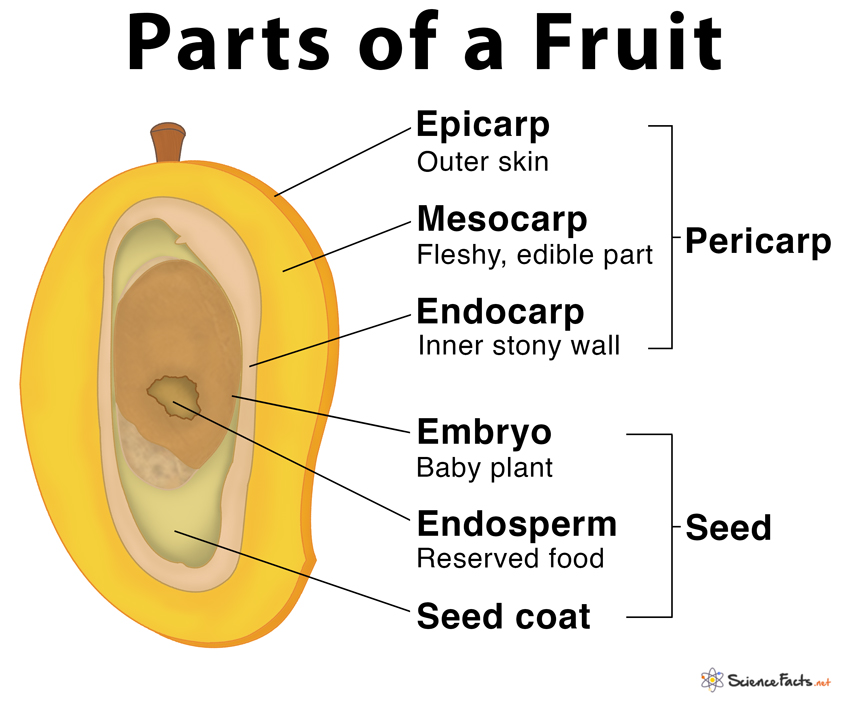
Fruits can be broadly classified into:
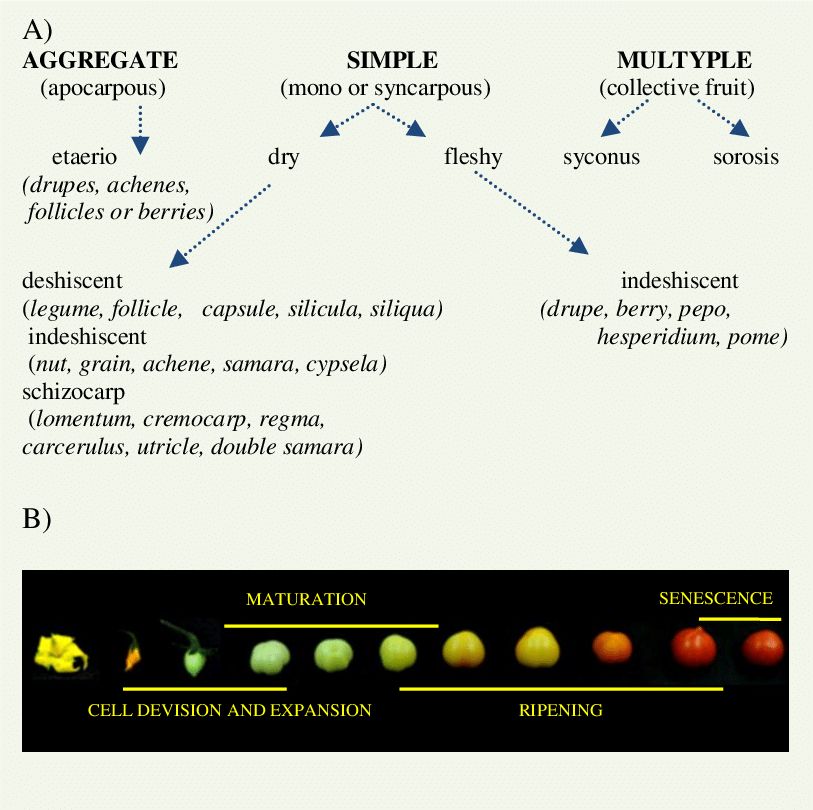
a. Simple Fruit: It is an indehiscent fruit derived from a single ovary having one or many seeds within a fleshy wall or pericarp: e.g. grape; tomato; cranberry.A simple fruit is further classified as dry or fleshy.
b. Aggregate fruit: Itdevelops from a flower having a polycarpellary apocarpous pistil. Each ovary develops into single simple fruit. Examples are blackberries and raspberries where each fleshy lobe is actually an individual fruit joined at their bases.
c. Multiple fruits: They are also called collective fruits. In this, the fruiting bodies are formed from a cluster of flowers, the inflorescence. Each flower in the inflorescence produces a fruit, but these mature into a single mass. After flowering, the mass is called an infructescence.Examples are, Pineapple and Mulberry.
Fruits are also classified on the basis of formation as True fruits, False fruits, and Parthenocarpic fruits.
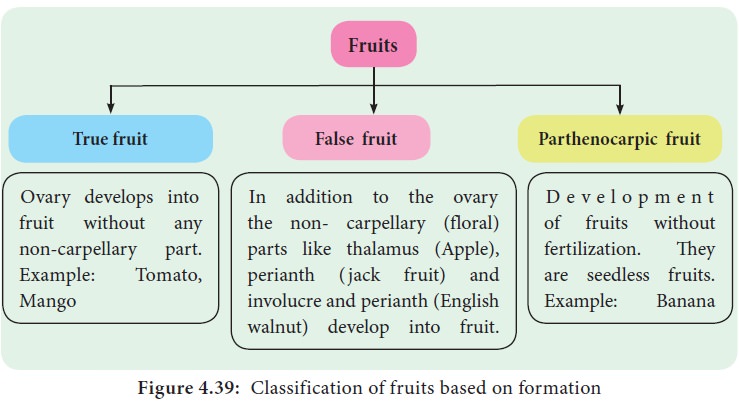
The Seed
- Books Name
- ACME SMART COACHING Biology Book
- Publication
- ACME SMART PUBLICATION
- Course
- CBSE Class 11
- Subject
- Biology
THE SEED
Morphologically, ripened ovule after fertilisation is known as seed. Seeds are characteristic of spermatophytes (Gymnosperms and Angiosperms).
Parts of Seed
1. Seed coat
Outer, protective covering of the seed is called seed coat, which develops from integuments of ovule.
In seeds developing from bitegmic ovules, there are two distinct layers in seed coat.
The outer layer is thick, hard and leathery (developing from outer integument), called testa, whereas inner layer is thin and papery (developing from inner integument), called tegmen.
In seeds, developing from unitegmic ovules there is single seed coat.
All the structures inside seed coat constitute kernel, while Hilum is a scar on seed coat through which the developing seeds are attached to the fruit.
2. Embryo
Embryo is the most important part of the seed, which represents tiny future plant.
The embryo is having an embryonal axis or main axis called tigellum, to which one or two cotyledons (seed leaves) are attached, depending upon whether the seed is monocot or dicot.
The portion of embryonal axis or tigellum below the point of attachment of cotyledons, is called hypocotyl, which bears radicle or future root at its tip.
Similarly, portion of embryonal axis or tigellum above the point of attachment of cotyledons, is called epicotyl, which bears plumule (future shoot) at its tip.
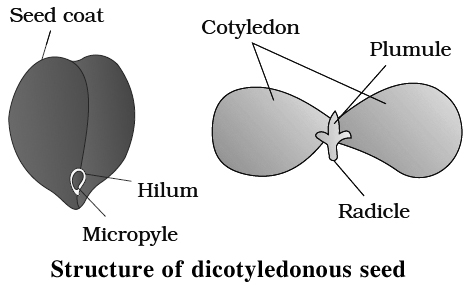
In castor seed (Ricinus communis), there is a specific outgrowth called caruncle present over hilum. It is formed by proliferation of cells of outer integument at tip. Caruncle is somewhat spongy and helps in absorption of water during germination of seed.
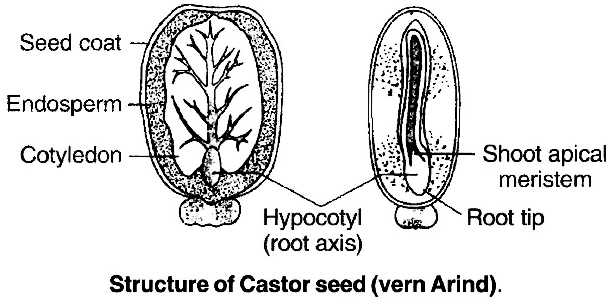
Based upon presence or absence of endosperm the seed may be of two types:
(1) Non-endospermic or exalbuminous seeds: In seeds like gram, pea, groundnut, the endosperm is completely consumed by the embryo, thus the seeds are called non-endospermic or exalbuminous e.g., dicots.
(2) Endospermic or albuminous seed: In monocots and castor bean (dicots) embryo does not consume all endosperm. So it persists in the mature seed. Such seeds are called endospermic or albuminous seeds. In these seeds food is stored in endosperm.
Perispermic seeds:
Mostly nucellus is consumed after fertilization due to absorption of food by the endosperm and embryo.
Sometimes, the nucellus remains persistent in the seed and is called perisperm.
Such seeds are called perispermic seeds, e.g., Piper nigrum (black pepper).
Chalazosperm is perisperm like tissue in chalazal region. It is a substitute for endosperm e.g., Cynastrum.
Internal structure of maize seed
On the outside of the grain is present a single thin but hard covering.
It is formed by the fusion of the seed coat or testa and the fruit wall or pericarp.
Below the grain covering are present two structures, endosperm and embryo.
The endosperm consists of two parts, horny aleurone and mealy storage.
The aleurone region lies immediately below the grain covering.
The cells have thick walls and dense cytoplasm filled with aleurone or protein grains.
The latter produce enzymes during the process of grain germination.
The storage region of endosperm is whitish or yellowish.
It is rich in starch grains.
The embryo occurs in the pointed part of the grain, mostly towards the upper side.
It consists of an embryo axis containing a radicle, a plumule and a single, shield shaped, lateral cotyledon.
It has two protective sheaths, radicle sheath is called coleorhiza and a conical protective sheath of plumule is known as coleoptile.
Coleoptile has a terminal pore for the emergence of first leaf during germination.
The sheath is capable of growth.
It assists the future shoot in passing through the soil during germination.
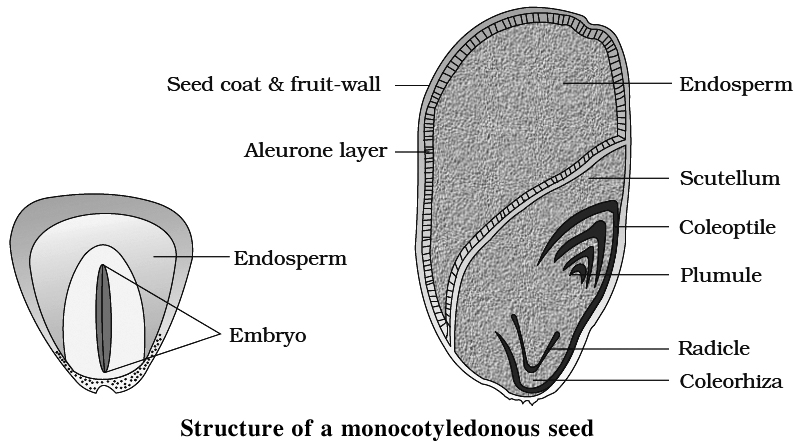
The single cotyledon of Maize grain is called scutellum.
It occupies the major portion of the embryo region of the grain.
The outermost layer at the boundary of endosperm and embryo is known as epithelial layer.
It is both secretory and absorptive.
The epithelial layer secretes hormones into the endosperm for the synthesis of enzymes required for solubilisation of food.
The solubilised food is absorbed by it and then transferred to the embryo axis.
On opposite side of scutellum is present a tongue shaped flap like outgrowth called epiblast, it represent the remains of second cotyledon.
The Seed
The Seed
After fertilization, the ovules mature into seeds. A seed consists of two parts: a seed coat and an embryo. A radicle, an embryonal axis, and one (as in wheat, maize) or two cotyledons make up the embryo (as in gram and pea).
Structure of a Dicotyledonous Seed:
The seed coat is a seed's outermost coating. The outer testa and the inner tegmen are the two layers of the seed coat. The hilum is a scar on the seed coat that was used to adhere the developing seeds to the fruit.The micropyle is a tiny pore located above the hilum. The embryo, which consists of an embryonal axis and two cotyledons, is contained within the seed coat. The cotyledons are usually plump and rich in food reserves. The radicle and the plumule are located at the two ends of the embryonal axis. The endosperm developed as a result of multiple fertilization in some seeds, such as castor, is a food-storing tissue and is referred to as endospermic seeds.The endosperm is absent in mature seeds of plants such as beans, gram, and pea, and these seeds are referred to as non-endospermic.
Structure of Monocotyledonous Seed:
Monocotyledonous seeds are usually endospermic, but some, such as those found in orchids, are not. The seed coat of cereal seeds, such as maize, is membranous and usually united with the fruit wall. The endosperm is a thick substance that stores food. A protein layer termed aleurone separates the embryo from the endosperm's outer covering. The embryo is tiny and rests in a groove on one end of the endosperm. It consists of a scutellum, a big shield-shaped cotyledon, and a short axis with a plumule and radicle. Coleoptile and coleorhiza are sheaths that surround the plumule and radicle, respectively.
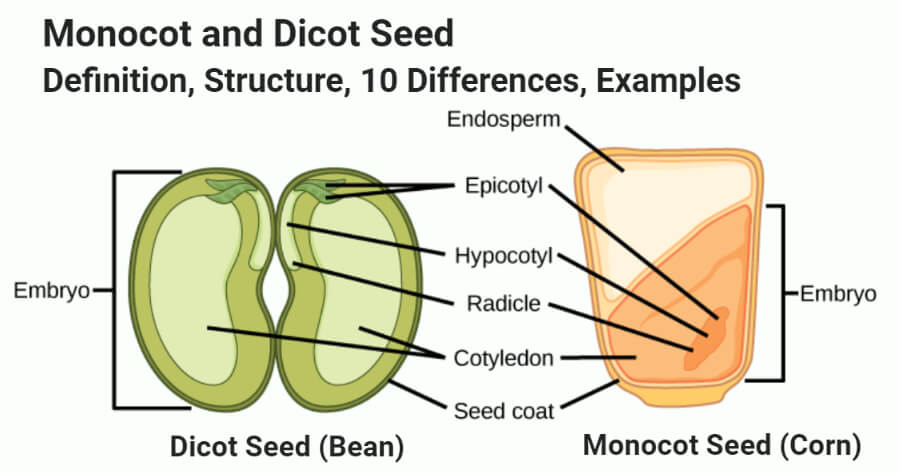
Semi-Technical Description of a Typical Flowering Plant
- Books Name
- ACME SMART COACHING Biology Book
- Publication
- ACME SMART PUBLICATION
- Course
- CBSE Class 11
- Subject
- Biology
SEMI-TECHNICAL DESCRIPTION OF A TYPICAL ANGIOSPERMIC PLANT
Different characteristics of a family are the diagnotistic features which enable us to differentiate them.
These diagnostic features are mainly based on floral characters like sexuality of flowers, symmetry of flowers, position of ovary with respect to floral whorls, bracts, and conditions of calyx, corolla, androecium and gynoecium.
For a systematic study and quick comprehension of all the diagnostic features of a family, these characters are symbolised and put in the form of a floral formula.
Floral diagrams are also drawn which give some extra informations like placentation, position of the mother axis, aestivation etc.
Floral formulae and diagrams are given with the respective family descriptions later in the chapter.
Symbols used in Floral Formula
(1) Br : Bracteate flower
(2) Ebr : Ebracteate flower (bract absent)
(3) ![]() : Actinomorphic flower
: Actinomorphic flower
(4) % or + : Zygomorphic flower
(5) ![]()
 : Bisexual flower
: Bisexual flower
(6)![]()
 : Unisexual, male flower
: Unisexual, male flower
(7) 
![]() : Unisexual; female flower
: Unisexual; female flower
(8) K : Calyx
Kn : Polysepalous
K(n) : Gamosepalous
where n = Number of sepals
(9) Epi : Epicalyx (below sepals)
(10) C : Corolla
Cn : Polypetalous
C(n) : Gamopetalous
where n = Number of petals
(11) P : Perianth
(12) A : Androecium
![]() : Infinite stamens
: Infinite stamens
![]()
 : Epipetalous stamens
: Epipetalous stamens

![]() : Epitepalous or epiphyllous stamens
: Epitepalous or epiphyllous stamens
(13) G : Gynoecium
G(n) : Syncarpous ovary
Gn : Apocarpous ovary
Gn : Superior ovary

![]() : Inferior ovary
: Inferior ovary
where n = Number of carpels
(14) In the floral diagram the dot (•) represents the position of mother axis. It denotes the
posterior side of the flower.
Semi-Technical Description of a Typical Flowering Plant
Semi-Technical description of a typical flowering plant
A flowering plant is described using morphological characteristics.Vegetative elements such as roots, stems, and leaves are covered first in a semi-technical description of the flowering plant's behavior, followed by floral characters such as inflorescence and flower components.
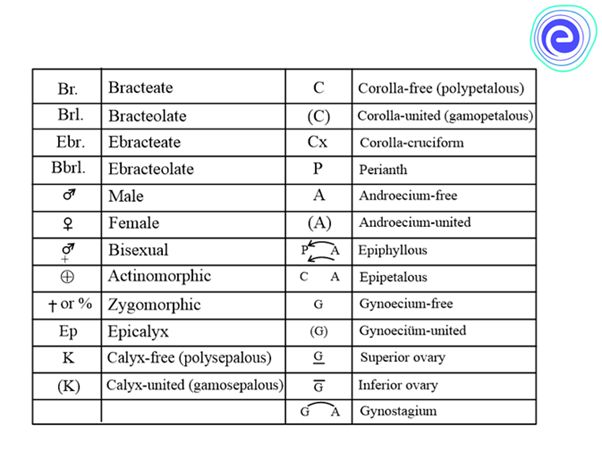
Various symbols in a floral formula are given above. The description must be concise, written in plain, scientific language, and given in a logical order. The plant's habitatand vegetative characteristics (roots, stem, and leaves) are detailed first, followed by floral characters (inflorescence and flower components). A floral diagram is a visual representation of the structure of a flower. It depicts the number, arrangement, and fusion of floral organs. The flower's various components are represented by their respective symbols. Floral diagrams can be used to identify flowers or to better understand angiosperm evolution.The floral formula is a traditional way of describing a flower's structure. It designates different components of the flower with a combination of capital letters and symbols. A floral diagram and a floral formula are offered after discussing various elements of the plant. A floral diagram of a mustard plant is given below.
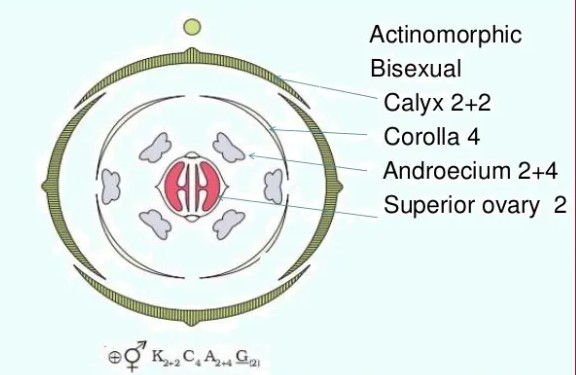
Some important families
- Books Name
- ACME SMART COACHING Biology Book
- Publication
- ACME SMART PUBLICATION
- Course
- CBSE Class 11
- Subject
- Biology
DESCRIPTION OF SOME IMPORTANT FAMILIES
This includes major distinguishing features and important plants of the family with floral diagram and floral formula.
1. Family Cruciferae (Brassicaceae) :
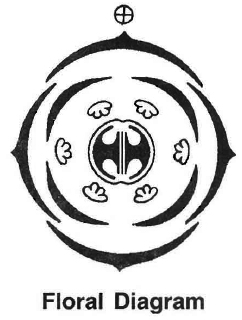
Distinguishing features:
(1) Inflorescence corymb or corymbose-raceme
(2) Flowers tetramerous
(3) Cruciform corolla
(4) Tetradynamous condition, sometimes didynamous
(5) Bicarpellary, syncarpous, superior ovary, unilocular but becomes bilocular due to false septum or replum, parietal placentation, stigma bifid.
(6) Fruit is silliqua or silicula
Floral Formula:
![]()
Important plants :
(1) Brassica campestris (Mustard)
(2) Brassica oleracea var. botrytis (Cauliflower)
(3) B. oleracea var. capitata (Cabbage)
(4) Brassica rapa (Turnip)
(5) Raphanus sativus (Radish)
(6) Iberis amara (Candytuft)
(7) Capsella bursa pastoris (Shepherd's purse)
(8) Brassica nigra (Black mustard)
(9) Brassica juncea (Indian mustard)
(10) Sissymbrium irio
2. Family Papilionaceae (Fabaceae) :
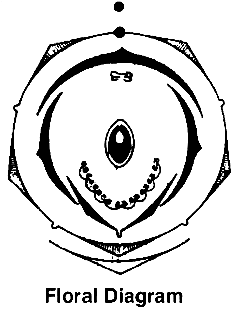
Distinguishing features:
 (1) Stem erect or climbing
(1) Stem erect or climbing
(2) Leaves alternate, pinnately compound or simple, stipulate, reticulate venation, leaf base pulvinate.
(3) Flower bisexual, perigynous, zygomorphic.
(4) Sepals five, gamosepalous, imbricate aestivation, odd sepal anterior.
(5) Petals five, polypetalous, papilionaceous (consisting of posterior standard, two lateral wings and two anterior ones fused to form a keel) vexillary aestivation.
(6) Stamen ten, diadelphous, anther dithecous.
(7) Monocarpellary, unilocular, superior ovary with marginal placentation, style single.
(8) Fruit legume or lomentum.
(9) Seed: One to many, non endospermic.
Floral Formula:
Br. %  K(5) C1+ 2 + (2) A1 + (9) G1
K(5) C1+ 2 + (2) A1 + (9) G1
Important plants :
(1) Pisum sativum (Garden pea)
(2) Lathyrus odoratus (Sweet pea)
(3) Sesbania sesban -Green manure
(4) Glycine max (Soya bean) -Edible oil
(5) Cajanus cajan (Arhar)
(6) Phaseolus aureus (Moong)
(7) Phaseolus mungo (Urd)
(8) Crotolaria juncea (Sunn hemp) -Fibre from stem
(9) Arachis hypogea (Ground nut) -Edible oil
(10) Cicer arietinum (Gram)
(11) Lens esculenta (Masur)
(12) Dalbergia sissoo (Shisham)
(13) Vida faba (Broad bean)
(14) Glycirrhiza glabra (Mulathi) -Root as medicine against throat infections
(15) Trifolium alexandrium (Berseem) -Fodder
(16) Cyamopsis tetragonoloba (Cluster bean, Gwar)
(17) Trigonella foenum graecum (Fenugreek)
(18) Medicago sativa (Lucerne)
(19) Butea monosperma (Flame of the forest)
(20) Indigofera tinctoria (Indigo) -Dye
(21) Abrus pecatorius (Ratti, Jeweller's weight)
3. Family Compositae (Asteraceae) :
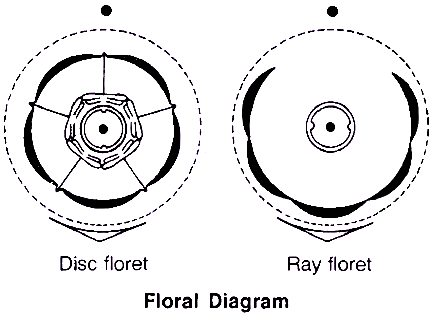
Distinguishing features:
(1) Inflorescence is head or capitulum.
(2) Flowers small, sessile, epigynous and are called florets.
(3) Calyx modified into hair like structure called pappus.
(4) Ligulate (zygomorphic) corolla in ray florets
(5) Tubular (actinomorphic) corolla in disc florets.
(6) Androecium 5, syngenesious, epipetalous, absent in ray florets.
(7) Bicarpellary, syncarpous, inferior ovary, unilocular with basal placentation.
(8) Fruit is cypsela.
(9) Largest and most advanced family of dicots.
Floral Formula:

Important plants :
(1) Helianthus annuus (Sunflower)
(2) Tagetes patula (Marigold)
(3) Carthamus tinctorius (Safflower)
(4) Chrysanthemum
(5) Dahlia
(6) Cosmos
(7) Aster
(8) Helichrysum (Everlasting or paper flower)
(9) Helianthus tuberosus (Jerusalem artichoke)
(10) Parthenium hysterophorus (Congress grass or carrot grass)
4. Family Solanaceae :
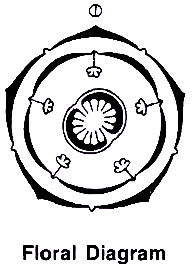
Distinguishing features:
 (1) Plants mostly herbs, shrubs and rarely small tree.
(1) Plants mostly herbs, shrubs and rarely small tree.
(2) Stem herbaceous, rarely woody, aerial, erect, cylindrical, branched, solid or hollow, hairy or glabrous (smooth), underground stem in potato.
(3) Leaves alternate, simple, rarely pinnately compound,exstipulate, venation reticulate.
(4) Inflorescence solitary, axillary or cymose as in Solanum.
(5) Flowers bisexual, actinomorphic.
(6) Sepals five, gamosepalous, persistent (Physalis, Brinjal) green or coloured, hairy, valvate aestivation.
(7) Petals five, gamopetalous, valvate aestivation
(8) Stamens five, polyandrous, epipetalous.
(9) Bicarpellary, syncarpous, ovary superior, bilocular with axile placentation
(10) Ovary obliquely placed, placenta swollen with many ovules
(11) Fruit berry or capsule.
(12) Seeds many, endospermous
Floral Formula:![]()
Important plants :
(1) Solanum tuberosum (Potato).
(2) Solanum melongena (Brinjal).
(3) Solanum nigrum (Black nightshade).
(4) Withania somnifera (Ashwagandha-medicinal plant).
(5) Lycopersicon esculentum (Tomato).
(6) Capsicum frutescens (Shimla mirch).
(7) Capsicum annum (Chilli).
(8) Cestrum nocturnum (Night jasmine).
(9) Brunfelsia hopeana (Yesterday-today-tomorrow).
(10) Datura alba (Datura) .
(11) Petunia auxillaris (Petunia) .
(12) Atropa belladona (Belladona -medicinal plant) .
(13) Physalis peruviana (Raspberry)
(14) Hyoscyamus niger (Henbane)
(15) Nicotiana tobacum (Tobacco)
5. Family Liliaceae :
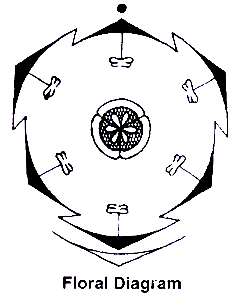
Commonly called the lily family, is a representative of monocotyledonous plants.
Distinguishing features:
(1) Plants are perennial herbs with underground bulbs, corms, rhizomes.
(2) Leaves are mostly basal, alternate, linear, exstipulate with parallel venation.
(3) Inflorescence is scapigerous cyme.
(4) Flowers bisexual, actinomorphic, hypogynous and trimerous.
(5) Perianth 6, in two alternate whorls, often united into tube, valvate aestivation.
 (6) Androecium 6, often epiphyllous.
(6) Androecium 6, often epiphyllous.
(7) Tricarpellary, syncarpous, superior, trilocular ovary with many ovules, axile placentation.
(8) Fruit is capsule, rarely berry.
(9) Seeds endospermous.
(10) Unisexual flowers in Ruscus and Smilax
Floral Formula:![]()
Important plants:
(1) Asphodelus tenuifolius (Piazi)
(2) Allium cepa (Piaz)
(3) Allium sativum (Garlic)
(4) Colchicum autumnale (Source of colchicine)
(5) Asparagus
(6) Aloe vera -Medicinal plant
(7) Yucca (Ornamental)
(8) Dracaena (Ornamental)
(9) Smilax
(10) Gloriosa superba (Dagger plant)
(11) Tulip (Ornamental)
(12) Ruscus
(13) Lilium (Lily) (Ornamental)
(14) Senseviera trifasciata (Mother-in-law's tongue) -Source of 'bowstring hemp'.
6. Family Gramineae (Poaceae) :
Most advanced family among monocots
(1) Inflorescence spike of spikelets (Triticum), panicle of spikelets (Avena).
(2) Flowers small, sessile, surrounded by two scales, lemma (fertile bract, inferior or outer palea) and palea (superior or inner palea) . The lemma bears a long, stiff process called awn.
(3) Flowers zygomorphic, incomplete, hypogynous.
(4) Perianth represented by two or sometimes three lodicules.
(5) Androecium 3 or 6, polyandrous, versatile fixation of anthers.
(6) Monocarpellary, superior, unilocular ovary with basal placentation. Stigma is feathery.
(7) Fruit is caryopsis or nut (Dendrocalamus) or berry (Bambusa)
Floral Formula:![]()
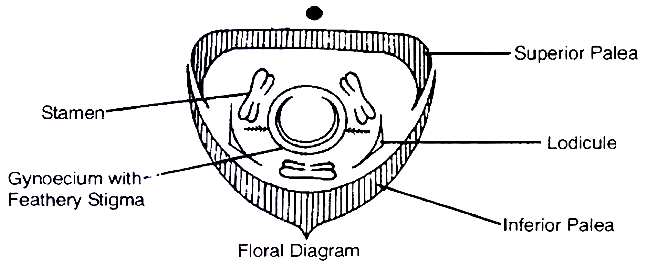
Important plants
(1) Avena sativa (Oat)
(2) Triticum aestivum (Wheat)
(3) Sorghum vulgare (Jowar)
(4) Pennisetum typhoides (Bajra)
(5) Hordeum vulgare (Jau)
(6) Saccharum officinalis (Sugarcane)
(7) Zea mays (Maize)
(8) Oryza sativa (Rice)
(9) Bambusa tulda (Bamboo)
(10) Cynodon dactylon (Doob grass)
(11) Secale cereale (Rye)
(12) Vetiveria zizanioides (Khus-khus)
(13) Cymbopogon citratus (Lemon grass)
Concept Builder
1. Gynobasic style arises from base of the ovary e.g., Labiatae (Lamiaceae).
2. Defense Mechanisms in Plants
(i) Thorns : e.g., Lemon, Pomegranate, Duranta
(ii) Spines : e.g., Agave Yucca
(iii) Prickles : e.g., Silk cotton tree, Rose
(iv) Stinging hair : e.g., Urtica dioica
(v) Glandular hair : e.g., Jatropha, Boerhaavia, Tobacco
(vi) Stiff hair : e.g., Gnaphalium
(vii) Latex : e.g., Ficus, Nerium , Euphorbia
(viii) Alkaloids : e.g. , Poppy, Datura
(ix) Geophilous habit : e.g., Ginger, Turmeric, Colocasia, Onion
(x) Mimicry : e.g., Arisaema, Sansevieria
3. Light, minute and powdery seeds : e.g., Orchids (smallest seeds), Grasses. Seeds of Moringa, Cinchona and Pinus are winged. Fruits of Acer, Hiptage, Terminalia, Dioscorea and Shorea are winged.
4. (a) Pappus: In membets of Asteraceae, pappus help in wind dispersal called parachute
mechanism. e.g., Taraxacum. Sonchus, Tagetes.
(b) Censer mechanism of dispersal is found in Poppy, Argemone, Antirrhinum .
(c) Rolling mechanism of dispersal is found in Amaranthus, Carthamus. These are called
tumble weeds.
(d) Winged seeds : Seeds of Moringa, Cinchona and Pinus are winged.
(e) Winged fruits : Fruits of Acer,Hiptage, Terminalia, Dioscorea and Shorea are winged.
5. Dispersal by water or Hydrochory -Fruits and seeds showing dispersal by water have floating devices. e.g.. spongy thalamus in lotus, spongy and fibrous outer walls in coconut and double coconut.
6. Dispersal by explosion or Autochory: Ruellia (dispersal using jaculator), Ecballium (dispersal by fountain mechanism).
7. Leguminosae is divided in three subfamilies -Fabaceae, Caesalpiniaceae and Mimosaceae -The major classifying character between these families are character of corolla and stamens.
8. Entire stem is tuberous in knol-khol (Brassica oleracea var. gongyloides).
9. Plant with largest leaf -Victoria amazonica (victoria lily).
10. Plant with longest leaf -Raphia vinifera (palm).
11. Acaulescent -Plant with reduced stem.
12. Stipule like structures in axis of leaflets are called stipels, e.g., Dolichos.
13. Staminodes (sterile stamens) are characteristically present in family Caesalpiniaceae.
Summary
Flowering plants exhibit enormous variation in shape, size, structure, mode of nutrition, life span, habit and habitat.
They have well developed root and shoot systems.
Root system is either tap root or fibrous. Generally, dicotyledonous plants have tap roots while monocotyledonous plants have fibrous roots.
The roots in some plants get modified for storage of food, mechanical support and respiration.
The shoot system is differentiated into stem, leaves, flowers and fruits.
The morphblogical features of stems like the presence of nodes and internodes, multicellular hair and positively phototrophic nature help to differentiate the stems from roots.
Stems also get modified to perform diverse functions such as storage of food, vegetative propagation and protection under different conditions.
Leaf is a lateral outgrowth of stem developed exogenously at the node.
These are green in colour to perform the function of photosynthesis.
Leaves exhibit marked variations in their shape, size, margin, apex and extent of incisions of leaf blade (lamina).
Like other parts of plants, the leaves also get modified into other structures such as tendrils, spines for climbing and protection respectively.
The flower is a modified shoot, meant for sexual reproduction, The flowers are arranged in different types of inflorescences.
They exhibit enormous variation in structure, symmetry, position of ovary in relation to other parts, arrangement of petals, sepals, ovules etc.
After fertilisation, the ovary is converted into fruits and ovules into seeds.
Seeds either may be monocotyledonous or distotyledonous.
They vary in shape, size and period of viability.
The floral characteristics form the basis of classification and identification of flowering plants.
This can be illustrated through semi-technical description of families.
Hence, a flowering plant is described in a definite sequence by using scientific terms.
The floral features are represented in the summarised form as floral diagrams and floral formula.
Some important families
Description of some important families
A. FABACEAE
It is also called Leguminosae, It consists of legumes such as the pea, or bean family, and is a large and agriculturally important family of flowering plants.
Vegetative Characters
Root: Dicotyledons, taproot with root nodules.
Stem: Erect or climber; Fabaceae includes shrubs, herbs, trees and majorly climbers.
Leaves: Petiolate, pinnately compound or simple; pulvinus leaf base, stipulate; reticulate venation.
Floral Characters
Inflorescence: Racemose.
Flower: Complete, bisexual, zygomorphic, hypogynous, bracteate/ ebracteate.
Calyx: Five sepals, gamosepalous; valvate or imbricate aestivation.
Corolla: Five petals, polypetalous, papilionaceous, vexillary aestivation.
Androecium: Ten stamens (9+1), diadelphous, anther dithecous.
Gynoecium: Superior ovary, monocarpellary, unilocular, single, short -style and flat, hairy-stigma.
Fruit: Legume.
Seed: One or more, non-endospermic.
Economic Importance
Many plants belonging to this family are economically useful. A few of them are listed below:
The plants of this family are unique and have root nodules that contain nitrogen-fixing symbiotic bacteria, capable of transforming atmospheric nitrogen into fixed nitrogen or ammonia. Pulses like gram, moong, and soya bean are the main source of food. The Mulethiplant is known for its medicinal value. Soya bean and groundnuts are used to extract oil that is used for cooking. Sunn hemp is the source
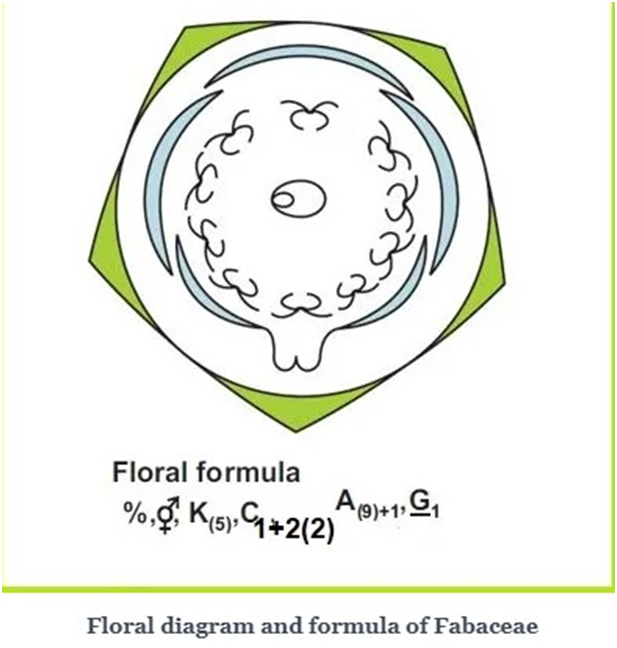
B. SOLANACEAE
It is a family of flowering plants that ranges from annual and perennial herbs to vines, epiphytes, shrubs, and trees, and includes a number of agricultural crops, medicinal plants, spices, weeds, and ornamentals.
Vegetative Characters
Root System: Taproot system.
Stem: Erect or climber; Solanaceae includes herbs, shrubs, small trees, and climbers.
Leaves: Alternate, simple or pinnately compound (rarely); exstipulate; reticulate venation.
Floral characters
Inflorescence: Racemose- terminal or axillary raceme; Cymose- solitary in Solanum.
Flower: Complete, bisexual, actinomorphic, hypogynous.
Calyx: Five sepals, gamosepalous; valvate aestivation.
Corolla: Five petals, gamopetalous, valvate aestivation.
Androecium: Five stamens, epipetalous; anthers basifixed.
Gynoecium: Syncarpous, bicarpellary, bilocular, superior ovary, axile placentation.
Fruit: Berry/ capsule.
Seed: Numerous, endospermic.
Economic Importance
These are an important source of food. E.g. tomato, brinjal and potato. These are important sources of spices. E.g. chilly. The leaves of Nicotiana tabacum are a major source of tobacco.These are also used as ornamental plants. E.g. petunia. Plants such as Belladonna and Ashwagandha are also used as medicinal plants.
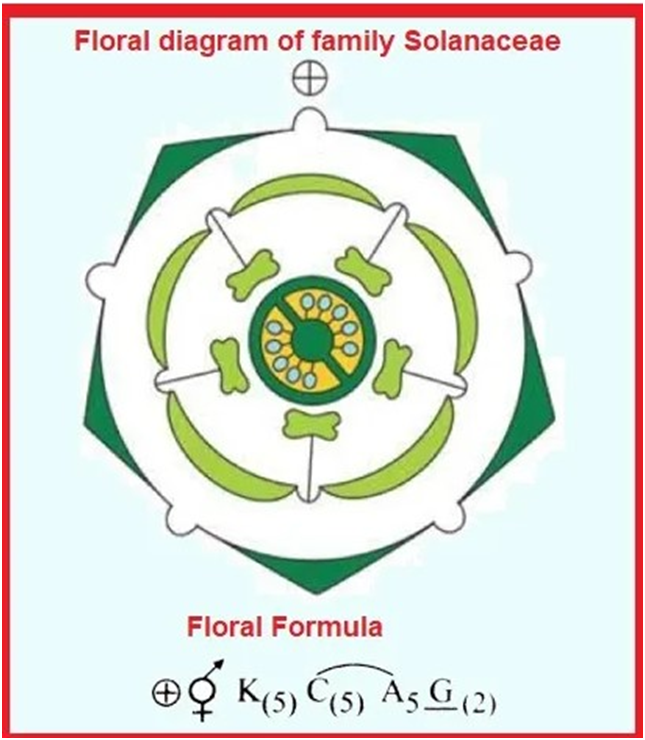
C. LILIACEAE
Liliaceae is the family of around 2500 species of perennial, herbaceous monocots. It is also known as the ‘lily family’.
Vegetative Characters
Root: Fibrous root system.
Stem: Erect; Liliaceae includes perennial herbs which propagate through bulbs or rhizomes.
Leaves: Alternate, simple; exstipulate; parallel venation.
Floral characters
Inflorescence: Cymose- solitary; umbellate clusters.
Flower: Complete, bisexual, actinomorphic; hypogynous, perianth present.
Perianth: Indistinctive sepal and petal; six tepals (3+3), often united tepals; valvate aestivation.
Androecium: Six stamens in two whorls (3+3).
Gynoecium: Syncarpous, tricarpellary, trilocular, superior ovary with axile placentation.
Fruit: Mostly Capsule and sometimes berry.
Seed: Endospermic seeds.
Economic Importance
The plants belonging to the Liliaceae family are a source of Medicine -Aloe vera, Smilax and Colchicine. They are also used as ornamental plants -Lilium, tulips, Gloriosa, and Ruscus. They are also exploited as a source of food (or) Vegetables-Asparagus.Bulbs of Allium cepa and the roots of various species of Smilax are used as flavouring agents.


 ACME SMART PUBLICATION
ACME SMART PUBLICATION
